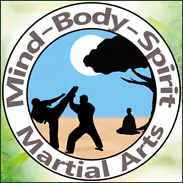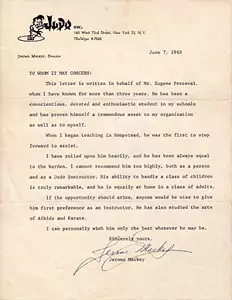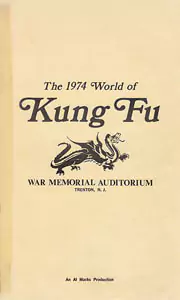The Story of:
Grand Master Gene Perceval and his Martial Arts History
The Story of:
Grand Master Gene Perceval, and his Martial Arts History
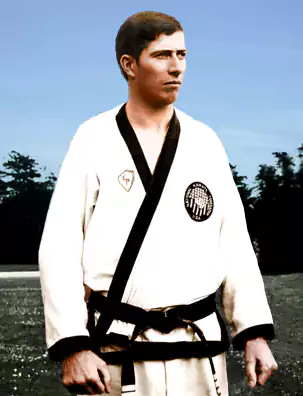

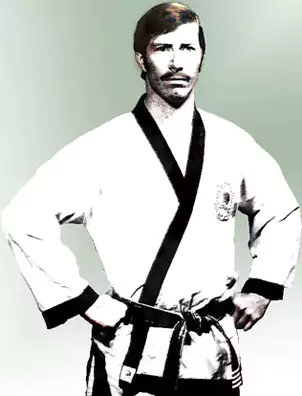

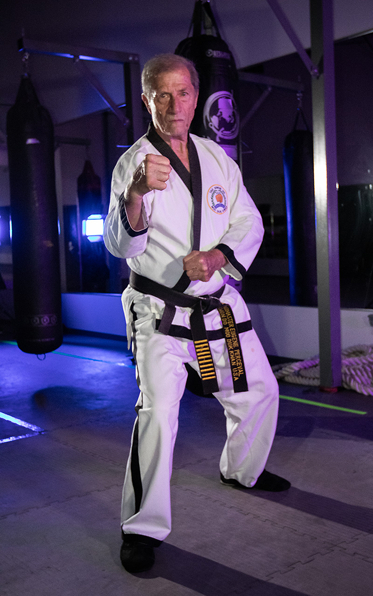

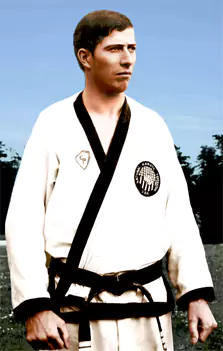
(very young)

Introduction
My interest and curiosity in the martial arts began in 1952, when I was twelve years old. Whenever I had earned an allowance for doing chores around the house – which was one dollar per week – I sometimes spent it on going to the movies, on a Saturday afternoon. Back then, you could see two main featured movies, a cartoon or two, and a movie-tone (which was about current events and interesting happenings around the world) for fifty cents.
One movie series I enjoyed the most
Mr. Kentaro Moto, better known as Mr. Moto, was a fictional Japanese secret agent and detective who portrayed an international law enforcement agent in the movies. Mr. Moto appeared in a series of eight motion pictures from 1937 to 1939. Mr. Moto was a short, soft-spoken man who was always very polite and courteous. He also spoke fluently in several languages, and he wore many different disguises while solving international crimes. His character was played by Slovakian-born actor Peter Lorre. Peter stood five foot three and resembled a delicate, fragile man who seemed to fit the part of Mr. Moto's character very well.
My first exposure and interest in the martial arts


I always enjoyed suspense, detective movies. What drew my attention to the Mr. Moto movie series was his role in solving crimes, particularly near the end of each movie when the plot thickened and Mr. Moto found out who the criminal was, usually a much taller, bigger man than Mr. Moto. Mr. Moto would use his Judo or Jujitsu skills to hopelessly throw the bad guy down to the ground. The police usually then arrived and took the bad guy away into custody.
Mr. Moto was my first exposure to the martial arts. Some time later in my life, I found out that Peter Lorre (Mr. Moto) didn't actually throw the bad guys down. He had physical problems and therefore used a stunt double instead. However, because of my fascination with the movie series of Mr. Moto, I had started looking into how I could learn Judo or Jiu-Jitsu. Unfortunately, I came up empty handed.
Black belts coming to America
The war between Japan and South Korea ended in 1945, and American service men stationed in Okinawa and Japan were the first black belts to return to the United States around the early part of the 1950's. The service men trained for three to five years in the Orient to obtain their black belt.
In the beginning, I taught myself Judo & self-defense from books
While I was looking through a magazine around thirteen or fourteen years old, I noticed there was an ad that read, "Learn Judo and Self-defense." The ad was advertising judo and self-defense books. The books were twenty five cents each. I wanted all four of them so I folded a piece of paper around a one dollar bill, stuffed it into an envelope and sent it off to the book distributer in New York City. I waited impatiently for my books to arrive (which seemed like forever), but they never arrived. So I called the book distributor.
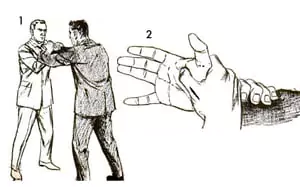

I can't recall our exact phone conversation but as a result, I decided to take a train ride into New York City to visit the book distributor (which was less than 25 miles away). It was a forty minute train ride on the Long Island Railroad. I arrived at the building. And behind the counter on the second floor, the book distributor said he didn't receive the money that I had sent him. It must have been my lucky day because, the distributor said he had recently received a new shipment of Judo and self-defense books and he gave them to me for free. Each book was eight inches high and about six inches wide. The pages had hand-drawn ink pictures of self-defense movements. At the bottom of each page were hand-written captions about how to execute each movement. During the train ride home, I remember feeling very excited while glancing through the books. From that day forward I studied the books intently, practicing what I learned in front of the mirror, trying to visualize how each movement was done.
I continued to ask about where I could take self-defense lessons, however I couldn't find a local instructor.
Finally, through a friend, I got a lead
Not the actual building
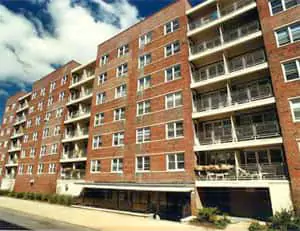
During the summer of 1955, I had lots of friends at almost the age of fifteen. I told one of my friends about my interest in wanting to learn judo and self-defense. He then told one of his friends about my interest in wanting to learn. It turned out that, my friend's friend lived in an apartment building about two miles away from me, and he knew of a tenant who lived in the same apartment building as him who taught Judo in the basement during the evenings several times a week. My friend's friend then relayed my interest in wanting to learn the martial arts to the Judo instructor.
Patience is a virtue, something that must be learned and practiced
Not long after my friend talked to the judo instructor, word got back to me that I could come by and meet him during one of his classes. I had arrived early, and I waited at the basement door for someone to show up. The instructor showed up wearing his Judo uniform, carrying his black belt. He unlocked the door and invited me in. "You must be Gene?" he said. "The rest of my students will be here shortly." The instructor was a tall, thin man in his late twenties.
Before class started, I was instructed to sit down and cross my legs, and not lean against the wall. And I was also told to remain quiet. His class had six men, all around the same age as him. One of them wore a brown belt, another a green belt, and the rest were wearing white belts. I sat there for about two hours watching and listening until the class ended.
After class, the instructor approached me and asked if I liked the class, and if I wanted to learn. I replied, "Yes!" I was all excited. He gave me the class schedule and his price (which was real cheap) and invited me back.
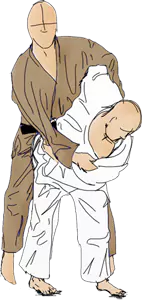



The second time I returned, I was expecting to be part of the class, participating, but when class started, I was told to sit on the floor again like last time and just watch. This continued for about a month or so until eventually, right before the end of one class, the instructor turned to me and waved me onto the mat. The instructor handed me the top portion of a Judo uniform. I put it on. He then tied a white belt around my waist. He grabbed my lapel and sleeve and instructed me to do the same. "Throw me" he said. We moved around for while as I was tugging and pulling, trying to offset his balance. Somehow, I managed to get my hip under him and flipped him over onto the mat. The instructor then complimented me on the throw. I felt proud of myself. He asked me to do it again. But before I had a chance to reciprocate, like lightening, he immediately threw me to the mat. The instructor was not so gentle this time. As soon as I stood up, he did it again, one take-down after another. By the end of it all, I couldn't stand up straight or maintain my balance.
Finally, I'm a student
Actual Judo uniform from instructor
George Smith (from mid 1950's):
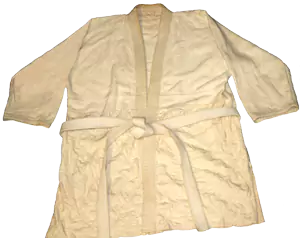

Actual Judo uniform from instructor
George Smith (from mid 1950's):


The class formally ended and the instructor gave me the bottoms to my judo uniform and said, "The uniform is yours to keep. I'll see you at the next lesson. And you'll be joining the class." Before leaving class, one of his white belts explained to me "every student who came here seeking lessons, went through the same thing as you did, they sat here on the side, and just watched the class."The white belt further said that "the instructor does this to weed out those who are really interested and sincere about learning, and those who aren't." I thought to myself, you can learn a lot just by sitting and watching. The white belt continued, "You're not the first young man who came here wanting to learn judo." "Others before you had expressed interest and had only showed up for one or two lessons and never bothered to return." He said that, "The instructor is very selective about who he teaches." "He took lessons for four years before he made black belt." We had talked for a while longer. I found out that the instructor was in the military stationed in Japan, and that his instructor's instructor was Japanese; his name I forgot.
More about my Judo instructor
My instructor's name was George Smith. He worked during the day and taught Judo and self-defense classes at night on some evenings. Occasionally, when he got stuck late at work and couldn't make the class, the classes' brown belt taught. After class, Mr. Smith sometimes sat in with us and talked about many different subjects. One of the many interesting stories Mr. Smith told us about, was the opportunity to do a television commercial for Timex watches. The television show had aired the commercial live. Back then, live television was more common until the late 1950's, when videotape technology was invented. Mr. Smith's role was to wear his judo uniform while he chopped several boards in half wearing a Timex watch on his wrist. Upon breaking the boards, the camera did a close-up of my instructor's wrist showing the Timex watch he was wearing and how it was still ticking. Timex's slogan was, "It takes a licking and keeps on ticking." My instructor said the watch was especially made for the commercial. After the live show my instructor left the studio still wearing the Timex watch (by accident).
A year and a half later, my judo instructor moved away and classes ended.
I joined a Judo – Aikido school in New York City
During one winter in the 1950's when I was sixteen, I recall seeing more martial art schools appearing in the New York City area and on Long Island than ever before. At some point over the next year or so, I moved to New York City with my mother. I began taking lessons at Jerome Mackey's school, called "Judo, Self-defense Aikido School," located on 160 West 73rd street in the basement (again) of an apartment building. The mat room was small, and rarely did I see Jerome Mackey on the mat teaching. Instead, his classes were taught mostly by top Judo champions he had hired from Japan. They were here in the United States as exchange students learning English.
Some of my instructors from Jerome's school were: Matsamoto, Katsuo Watanabe, Uneska, Shunichi Ito, and Shina (who was the shortest of them all).
My short training in Kung Fu
Five and a half miles from Jerome Mackey's school, downtown in New York City, was a Kung Fu school in China Town I joined. The school was on the second floor, close to the Manhattan bridge. The Chinese style was Fu Jow Pai, or "Tiger Claw System." I trained there for several months. The Chinese instructor was excellent and the classes were also very good. However, the Tiger Claw style was just not my cup of tea, so I left.
I moved back to Long Island and joined another martial arts school
As a brown belt, I joined another martial arts school that taught Judo self-defense and Karate lessons. The martial arts school was originally a store. It was located in the middle of a block with many other stores connected on both sides on a major road. There were a handful of instructors there (I can remember) who came and left but never returned. The school wasn't doing well, and the classes were getting smaller. Eventually the school went out of business.
I'm back, learning from the same instructors that were in the city
About two weeks later, driving by the same school that just closed (which I was a student of), I had noticed a sign in their window that said Jerome Mackey was opening a new school at that same location. Driving by a second time, I saw workers putting up a new sign on the building. I also saw workers inside preparing the school, so I stopped in.
Jerome Mackey
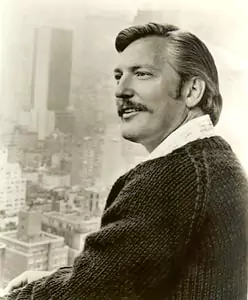

Jerome Mackey


I noticed Jerome Mackey in the back. So I walked up behind him and just stood there. When he turned around, he recognized me immediately and gave me a big smile. I was the first student in his new school. We talked for a while. As he was showing me around, Jeanne walked in. Jeanne was the receptionist there, at that school, before Jerome Mackey took it over. Jeanne and I were good friends. I introduced Jerome to Jeanne. She came in to apply for the receptionist job. She got hired right on the spot. Within a week or two, the school opened.
Jerome Mackey had set up his school very nicely.
Describing Jerome Mackey's new school
Jerome Mackey's School
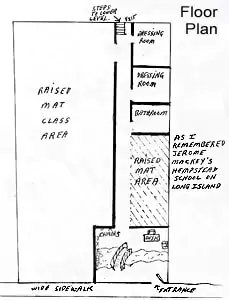

Jerome Mackey's School


As soon as I opened the front glass door (on the right-hand side of the building) to Jerome Mackey's school, I heard soft Oriental music playing which set the mood. Lights hung from the ceiling that looked like Oriental lanterns. The walls were covered with bamboo and other decorations resembling a typical Oriental village. Several feet past the door was a small wooden arched bridge with handrails. Under the bridge was a stream with fish in it and it ran the full width of the reception area. The end of the stream opened up to a pond resembling a Japanese garden. I had to walk over the bridge to get to the reception desk. On the other side of the bridge was the reception area, where chairs were placed about for guests to sit in and relax by the stream. (Students were not permitted to hang out in the reception area). To the left of the reception desk – behind it was a wall that ran the full length of the school. On the right side, was a raised matted area that was designated for private or semi-private classes, warm-ups, stretching or practice before class started. Continuing past the mat were dressing rooms and bathrooms. Further along continued the long hallway which stretched all the way to the back of the school, which lead to a double staircase at the end. Down the staircase was the basement which ran the full length and width of the school, and was used for conducting Karate lessons (the area wasn't matted). Back up the stairs – facing toward the front of the school, at the top of the stairs at the end of the hallway – to the right-hand side, opened up to a large matted room which was about twenty-five feet wide, and had expanded all the way to the front of the school.
I was an assistant to the Judo and Aikido instructors
In 1958, I was going on eighteen. I was a 1st kyu brown belt. At Jerome Mackey's school in the city on 73rd Street, some of his Japanese instructors had also been teaching at his school on Long Island. So I knew them well.
In the city, I attended every class I could, for my age group and grade. As time passed, the Japanese instructors had taken a liking towards me. Whenever it came time to demonstrate a technique to the rest of the class, I became their "Uke" (the one to be demonstrated on). Whenever the black belts worked-out together, privately, which was after class, I was always included. This was a great way for me to get advanced training.
Large classes at Jerome Mackey's school had more than one instructor. Of these large classes that I wasn't participating in as a student, I assisted the instructors in teaching the class to offset the cost of my lessons. After warm–up and stretches, the instructors had me work with the beginners on one side. This gave the instructors the opportunity to separate the experienced students from the advanced ones.
My first martial arts injury
On an auditorium stage at a public-school, I was part of a six person Judo team putting on a Judo demonstration. On the stage were heavy, bulky mats (the only type of mats that were available back then). The mats were laid side by side so they could easily slide around to be put into place. Today however, the mats are thinner, lighter, and attach to each other using Velcro which prevents them from separating.
"Tomoe Nage"


"Tomoe Nage"


For the show, my partner and I were demonstrating a series of fast throws. During our last throw, my partner performed a "Tomoe Nage" on me – which is a technique that required my partner to anchor his leg to my abdomen (stomach) as he fell backwards, all while throwing me over his head using his foot, which flipped me onto the mat behind him where I landed on my back. Unfortunately, that never happened. As he fell and rolled backwards onto the mat, the mats separated and I found myself upside down in mid air. My entire body weight came crashing down on the back of my neck onto the wooden stage. We pushed the mats back into place, then performed the technique again, this time it was successful. By the time we got dressed, my neck was already stiffening up.
The following morning, I couldn't turn my head without turning my body even though I wasn't in severe pain. Over time, my head developed an uncontrollable tremor (shaking of my head). To this day, I still have a bad head shake from my Judo accident. In 2016, I was examined by a neurologist to see what could be done about my injury and the doctor told me surgery was my only option. I figured, since I lived this long with a head tremor, why not even longer?
About my Karate instructor: Master Ansei Ueshiro
Master Ansei
Ueshiro
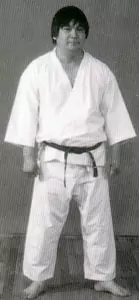

At Jerome Mackey's school, after Judo and Aikido classes, was Karate (which was always the last class). Karate class was held downstairs, below the main floor. I had to change from my heavy Judo top to my lighter Karate top, between classes. My Karate instructor was Master Ansei Ueshiro. He was born in Kin, Okinawa in 1933. Master Ueshiro's instructor was Grand Master Shoshin Nagamine. (During the early part of the 1960's, Master Ueshiro was teaching Shorin-ryu karate). Master Ueshiro was a direct descendant of the "Bushi," a term used to describe a Samurai Warrior. He was short (compared to most of us) and had somewhat of a stocky build. I recall him having a few finger tips missing on his right hand.
Master Ueshiro's requirements
Master Ueshiro's lessons were three times a week for newer students, four times a week for more advanced students. Classes were two hours long or longer sometimes, depending on what Master Ueshiro was teaching. Out of all my instructors that I had in the martial arts, Master Ueshiro's classes were by far the most demanding, both mentally and physically. His classes followed old, traditional martial arts. He required his students to learn and demonstrate martial arts etiquette and procedures, and to practice them correctly throughout every class. Master Ueshiro demanded perfect technique and nothing less. Anyone who was a beginner in his class had it the hardest because they were not mentally prepared for the vigorous training. Many had quit within the first month. When Master Ueshiro taught basic movements, he required you to practice them during class. And only when Master Ueshiro was satisfied with your technique would he show you another one. Once he showed you a new technique, from that moment on, you were expected to go home and practice. If you returned to class not showing any improvement, he would not teach you another one until you showed improvement. Master Ueshiro had several rules about self–improvement: 1) If you didn't understand something, ask, and 2) If you didn't practice or show improvement, then you weren't serious enough to be in his class. In other words, he felt that students falling behind were holding back his class.
Master Ueshiro's way to ensure that you learned correctly
Master
Ansei Ueshiro,
observing class
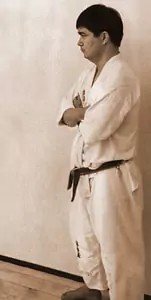

Master
Ansei Ueshiro,
observing class


During each class, Master Ueshiro had us practice from one end of the wooden training floor to the other doing basic movements and combination techniques, moving forward and backwards against each other while simulating free fighting. Master Ueshiro walked in-between the ranks of students, sometimes carrying a bamboo stick, using it to correct a student's improper body position or outer appendages – arm or leg – by pointing to that body part. If he thought you were continuously making the same mistake, Master Ueshiro would use his stick to whack you hard on that part of the body. When struck, it felt like a mean surface sting depending on the speed and force. The worst part was when Master Ueshiro used his stick on either your arm or leg, in which case the pain was deep. Also, when Master Ueshiro made corrections, he seemed to have a habit of hitting you in the same darn spot every time, especially before the spot had a chance to heal. Believe me, we learned quick that way. The only way to survive his class without being singled out was to practice during every free moment we had.
After training hard for two hours during class or longer, the last half hour was always the most grueling in Master Ueshiro's classes. We were pushed to the extent of exhaustion doing consecutive, repetitive techniques. Each student had their limits both mentally and physically. I had always continously pushed myself harder even though I already had great stamina (more so than the other students). Master Ueshiro's classes was a personal challenge to me. The only way to overcome his classes was to turn the negatives into a positive. His vigorous training turned me into a more positive thinker. I didn't realize the lesson in all this until I enlisted into the military. I'm sure the other students in the class – those who stuck it out with Master Ueshiro – realized the same.
Learning defense was more important than offense
Survival in the Orient and living in a village quite some time ago meant protecting and defending yourself, your family, home, crops, and village. You defended your stronghold, and focused on your enemy's weakest points and then used them as a strategy to counterattack. In Master Ueshiro's teachings, he followed the same principle. Your stronghold is weaker when you are in movement. This is when you're most vulnerable. When you hold your position and maintain a strong defense, you can counter attack with precision and force. Therefore, a great deal of time in Master Ueshiro's class was spent perfecting blocks. His principle was either block or get hit. Of course out of respect, your partner pulled his punches and kicks. When the defender got hit, injuries didn't occur (at least none that required first aid). The force was felt no more than a hard slap to the body. No groin and facial contact was permitted in his class. We were allowed to attack to the face or groin but we had to stop short of making contact. Back then body protection in the martial arts didn't exist, so you either blocked or got hit. It took a long time for my blocks to become effective. Eventually I became better at blocking than attacking. The constant practice of blocking made my forearms and lower legs harder. Years later it paid off during competitions because my blocks were almost impenetrable while being attacked by my opponent. This gave me the advantage because I could easily counter attack.
We were tough martial artists back then. We took the martial arts very seriously. To give you an idea of the type of class Master Ueshiro taught: after each class, our uniforms were soaking wet from perspiration. We could basically take off our uniforms and wring them out from sweat.
Reflecting back – and thinking about my martial arts instructors at Jerome Mackey's schools – many of them impacted my life in so many good ways including Master Ansei Ueshiro. I was fortunate enough to have him as an instructor. Sadly, Master Ansei Ueshiro died at the age of sixty nine in 2002.
Old school training is fading out in today's society
In today's society, an instructor could never survive financially or at least legally teaching the way the old, original masters did, such as Master Ansei Ueshiro. Culture has changed in modern times, and martial artists of today have other priorities such as work and school. Also, getting black and blue marks and being sore the next day no longer cuts it in today's world. That's the difference between the old masters: they were (are) true martial artists, not just practitioners. To them, the arts is something they lived, not just an artform they practiced passionately. Unfortunately, nearly all of the first-generation martial artists in the United States today (from the 1950's) have either passed away or aged to the point where they are no longer capable of teaching. Yet, there still remains a handful of old, masters such as myself who have maintained healthy and active lifestyles over the past sixty years and continue to teach the arts. Today's generation of martial artists only know of the martial arts and traditions as it was passed down to them by their instructors. After many generations of instructors passing down their knowledge, culture and various aspects of the traditional arts such as mental (mind), physical (body), spiritual (spirit), and etiquette – all of which were inspired by the original masters – these cultural traditions have become watered down. The only way to regain those lost traditions is to seek out the last remaining masters and preserve their way of life through some means in today's society.
My last memories before the military




My time at Jerome Mackey's Martial Art School was coming to an end. I was headed off to the military. After my last class at Jerome Mackey's school, a bunch of us went to the nearest lounge to celebrate my departure. While we were there, I noticed a baby grand piano. (Only a few of us at the time were aware that Jerome Mackey was a concert pianist). He spent nine years studying at Julliard and played at Carnegie Hall. Never having heard Jerome Mackey play before, I had asked him to play something. He gave me excuses – but with a little persistence, I eventually got him to sit down at the piano. He played magnificently. It was a moment that I will never forget.
Enlisting in the Army for three years
Gene Perceval (in the army)
Fort Dix, NJ (1963)
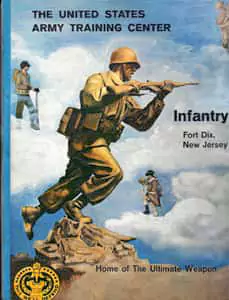

Gene Perceval (in the army)
Fort Dix, NJ (1963)


In 1963, the draft took effect. I was twenty three years old at the time. Each day coming home from work, the first thing I did was check my mail box to see if there was a letter in it regarding being drafted for military service. I had been expecting to receive something similar to what some of my friends had received: "You are ordered to report to induction at 39 Whitehall Street, in New York City." However, I never received such a letter. And I couldn't plan my future not knowing where I stood day to day; so I enlisted. I passed the physical for the armed forces (because I had two arms and two legs). After that, I sat down with an Army adviser and he said I had two options: 1) I could choose my career (job) providing I pass all the test requirements, or 2) I could choose a general location – that is of course, if I was not needed facing the enemy instead. I wasn't permitted to choose the exact location I wanted (which was Japan). However, my main interest was choosing a location where I could continue my martial arts training. Of the list they provided to me, I was allowed to select the Orient. In doing so, an agreement or "contract" was established. The army guaranteed me the Orient providing the needs of the army came first.
I'm in the Army Now
Paratrooper's School
Fort Benning, Goergia
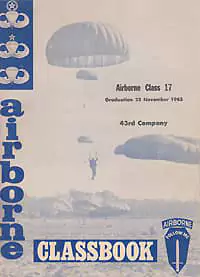

Paratrooper's School
Fort Benning, Goergia


"You're in the army now" is a take–off from a popular song in the 1940's, and a film directed by Lewis Seiler, Jimmy Durante, and Phil Silvers. I had reported to Fort Dix, New Jersey for basic and advanced training. I found both trainings relatively easy, mostly due to my past training in the martial arts, which prepared me both mentally and physically. However, many of my fellow recruits had a difficult time.
Paratrooper's School
Class of 1963:
Gene Perceval (at 22 yrs old)
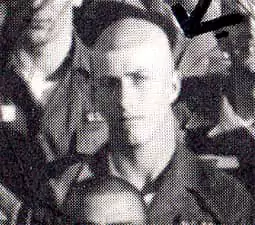

Paratrooper's School
Class of 1963:
Gene Perceval (at 22 yrs old)


Half way through my advanced training at Fort Dix, I applied for Special Forces. After completing my basic and advance training at Fort Dix, I was flown to Fort Benning, Georgia for paratrooper's school. One of the requirements to get into Special Forces, was that we had to complete paratroopers school first and receive our "wings" – which I did in November, 1963, Airborne class seventeen, number seven thirteen.
Special Forces training
Once I had passed paratrooper's school, I was relocated to Fort Bragg, North Carolina for Special Forces training (green berets). "De Oppresso Liber" in Latin stands for: "to free from oppression." Special Forces trained me to teach and advise indigenous personnel guerrilla warfare tactics. Because of this training, all those we trained were then able to teach their knowledge and skills to hundreds of other soldiers.
Gene Perceval (1963)
Fort Benning, Georgia
Receiving my "wings"
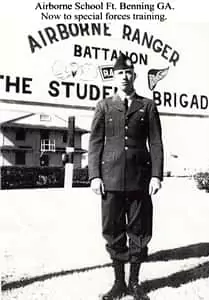

Gene Perceval (1963)
Fort Benning, Georgia
Receiving my "wings"


When my training was almost completed, I was unexpectedly called into the company commander's office. He informed me of an oversight that was caught regarding my enlistment contract about being stationed in the Orient (which was my original contract). In other words, the company commander didn't know I had requested to be stationed in the Orient. So he gave me a choice: 1) I could remain and finish my last few weeks of Special Forces training and graduate, or 2) terminate my Special Forces training and head off to the Orient. I choose to terminate and go to the Orient instead. My martial arts training was still very important to me. Looking back, I had made the right decision because the war in Viet Nam was getting hotter each day. And I was told some time much later that one of my buddies from Special Forces training was killed in Viet Nam.
Green Berets


The Viet Nam war lasted for twenty years from 1955 to 1975.
I received my overseas orders
I was hoping that I would get transferred to Japan so I could continue my education in Aikido, Judo, Jiu-Jutsu and Karate at the original source. When I received my new orders, however, I had been somewhat disappointed I was getting transferred to South Korea.
Jeep ride,
the outskirts of town
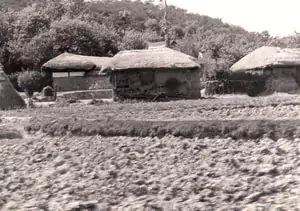

Jeep ride,
the outskirts of town


The military gave me three connecting tickets for commercial flights leaving from New York to California, California to Hawaii, Hawaii to Japan (stopping in Japan) and continuing to South Korea. The first two days in Korea I received army orientation. I learned about rules and regulations and living in South Korea.
My jeep ride to the army compound
"A" Frames used to carry
tremendous loads
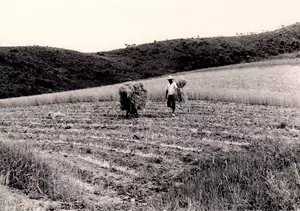

"A" Frames used to carry
tremendous loads


I was taken by jeep for about an hour's ride to the compound where I was going to be stationed. The jeep ride was like being in a time machine, living in a time and place where women walked completely open, breast feeding along the side of the road, and men carried "A" frames on their backs baring tremendous loads. The inhabitants used horses to pull two-wheeled carts to transport goods and oxen for farming. There were no paved roads (except for in Seoul), just lots of ruts and bumps. In my mind's eye, the jeep ride seemed to last forever (even as I write this).
Horse-drawn,
two-wheeled carts (in Seoul)
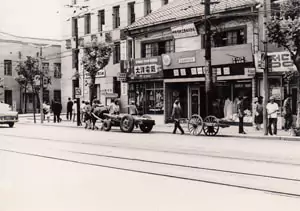

Horse-drawn,
two-wheeled carts (in Seoul)


It's difficult to describe one's emotions and feelings when time feels like it was standing still, especially when you are used to all the amenities back home and suddenly you're transplanted to a different culture where modernity doesn't exist. Both men and women were using the side of the road as a toilet. There was a strong smell (stink) of Kimchi, (a fermented cabbage kept in the ground in jugs during the winter) that filled the air. They dug it up when it got warmer. If you got close, your eyes would water. When I stop to think about it, everything was as it used to be: natural and simple. All I can say is, that the experience was, and still is, memorable.
Oxen used for farming
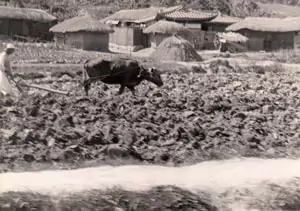

Oxen used for farming


Arriving at and describing the I-corps compound
Finally, I had reached the compound where I was stationed at. It was not too far from the DMZ (demilitarized zone) – a strip of land that separated both North and South Korea. I was then shown my living quarters. It was a corrugated, metal Quonset hut, about sixteen feet wide and thirty six feet long and had a door at both ends. There was a pot belly stove in the middle for heat. I had a single bed luckily, not a bunk bed. Everything was on a hill on the side of the mountain. Summers were very hot and Winters were freezing.
I Corps Compound:
Metal Quanset Hut:
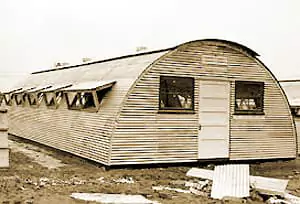
On the compound, I was introduced to my new job. It was one which I had no experience at and I needed training for. My job, along with several others was to coordinate and plot the location of missiles and other such weapons if they were fired by North Korea in the event of an attack by them. My trailer unit along with two other mobile units were stationed at different locations, coordinating and plotting together the location(s) of North Korean firing units. Our job was to then forward that information to our artillery division, either from the compound or when we out on maneuvers.
My job was similar to what an airport controller does today.
Describing the nearest town, Pobwon Ni
Large open field of rice patties
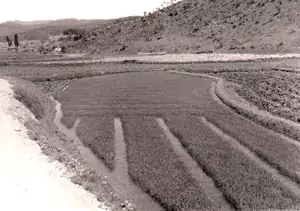

Large open field of rice patties


Once settled in at the compound, I walked about a mile along a narrow dirt road toward a small town. On my right, slightly below the road (heading into town) was a large open field of rice patties. There was a mountain range to my left where the compound was. During a hot day, when the wind came in off the fields, I sometimes got a good whiff of human excrement they used as fertilizer on the fields.
"Pobwon Ni" homes,
made of rice stalks


"Pobwon Ni" homes,
made of rice stalks


The outskirts of town was where most of everyone lived, in huts. Most of the huts were constructed of mud walls and covered with straw. Other huts were constructed of wooden boards with straw roofs (rice stalks). Back then, the Koreans developed their own technology to keep their huts warm during the Winter. They used a system of discarded food cans that they connected together to form hollow tubes, heating the air inside of them which also heated the surrounding mud under their huts.
Man selling metal food cans,
used for heating Korean homes
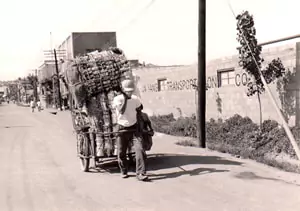

Man selling metal food cans,
used for heating Korean homes


The method in which they did this was, they first collected discarded food cans from outside of our camp (see picture), and removed the ends of the cans and connected them together to form hollow tubes. They then buried the hollow tubes in trenches under their huts in many rows, approximately one foot deep. Next, they back filled the trenches with mud. After that, a fire was built outside in a pit (which had to be maintained) connecting to all the cans that converged together, keeping their huts warm and cozy during the Winter. Typically, each hut was one room.
Towns folk selling, buying goods
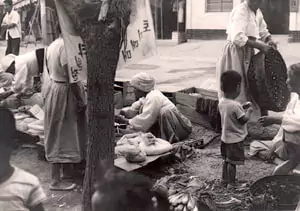

Towns folk selling, buying goods


The main part of town had shops which were connected to each other side-by-side. The shops were made out of raw-cut wood and were not particularly well-built. Much of everything that was needed was either made in town or grown. In a small section of town the GI's hung out in so-called "bars" (similar to the red-light district in Amsterdam). The "mama-san" ran the bars, and the women received a commission based on how many drinks they could sell to the GI's. When the GI's got stiff enough, the women guided them back to their huts and "conducted business." These women were the prostitutes of the town.
Shops made of raw cut wood
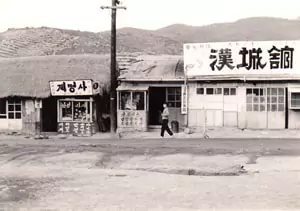

Shops made of raw cut wood


The town folks tolerated them because they were a major source of income for the town, but they were not respected. When the prostitutes spent their American money, it was worth far more than the Korean "Won."
"mama-san" ran the bars (prostitution)


"mama-san" ran the bars (prostitution)


Searching for a martial arts instructor
My main interest in having gone into town was to find out if there were any martial arts instructors there. I had no luck in finding one due to the language barrier. But back at camp, I had asked one of our katusas if he could help. A katusas is a soldier from the Republic of the South Korean Government who were already educated to speak English. They trained, lived, and ate alongside the American soldiers. After I made friends with a Kutusa, the next time we were in town together I had asked him if he could ask the townspeople if there were any martial arts instructors. He finally located one, the only one in town: Mr. Chun Chae Kyu. In Korea, "Chun" is the family name.
"Katusa" soldiers:


"Katusa" soldiers:


I was told that Mr. Chun could not give me lessons in his school and that other arrangements needed to be made. I had spoken with the company commander and explained to him my situation. Surprisingly, he was all in favor of me taking lessons from Mr. Chun Chae Kyu. My commander wanted to keep good relations with the local townspeople. He let me use the basketball court outside, on the compound for my lessons. If the weather was bad, we used a small area inside one of the huts.
My instructor:
Chun Chae Kyu
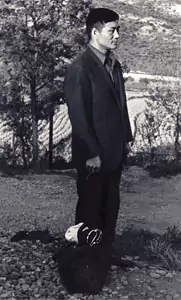

My instructor:
Chun Chae Kyu


Mr. Chun's fee was reasonable, even on my soldier's salary. No matter what the weather was, Mr. Chun always made it to the compound where we met at the gate. My lessons were three times a week for several hours.
Mr. Chun had never taught an American before, and he only knew a few words in English. I didn't know a single word in Korean.
Taking lessons under Mr. Chun, my instructor
In the beginning of my lessons with Mr. Chun, he wore a white uniform top with midnight blue trim, the same color as his belt. Mr. Chun did not display any stripes on his belt so I never knew his ranking. Therefore, I will call him Mr. Chun instead of Master Chun. One of Mr. Chun's instructors, Grand Master Hwang Kee, the founder of Tang Soo Do and Soo Bahk Do Moo Duk Kwan, was the person who chose the midnight blue color for the uniform's trim and belt in Moo Duk Kwan. One belief why Grand Master Kee chose midnight blue over black was because he believed that no one could ever achieve absolute perfection. That is why Grand Master Hwang Kee chose to use the midnight blue belt over the black belt.
Town near my compound
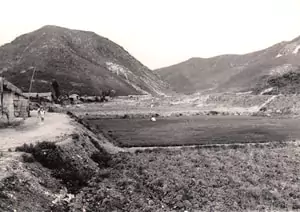

Town near my compound


Another belief was that the midnight blue sky was limitless, just like the training and knowledge one could attain over a lifetime. Koreans also felt that "black" represented the color of death.
My first lesson was in regular clothes. My next lesson, Mr. Chun brought me a new uniform with a white belt. It was also obvious during my first lesson that I had prior martial arts experience. I had the snap, power and technique that usually took a good year or longer to achieve.
Not being able to communicate with each other during lessons was not really much of a problem because a Kutusa was always nearby on the compound if we needed one, to communicate. Other than that, my lessons follows as "do as I do," and Mr. Chun made corrections accordingly.
Katusa's had their own
M.P.'s (military personnel),
seen on left in photo
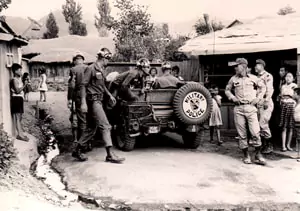

Katusa's had their own
M.P.'s (military personnel),
seen on left in photo


The basics and forms were almost identical to what I was learning back home in the United States, in the Okinawan style. However, I had to make some adjustments. The Korean stances were longer and lower, and the style I was learning (Moo Duk Kwan) was more focused on kicks. I moved along rapidly from lesson to lesson, mainly because I had plenty of free time to practice at the compound and because I had nine years of prior martial arts experience. Mr. Chun and I seemed to get along very well together. He smiled a lot during lessons. I made green belt, which I think occurred two month's in (to my lessons). As a green belt, we made a few trips to surrounding towns to visit nearby martial arts schools where Mr. Chun had me do forms and free fighting, which I always enjoyed.
To keep in shape and maintain my endurance, each morning I ran five miles (with my combat boots on).
I Corps 5 mile race (1965),
Gene Perceval 2nd place
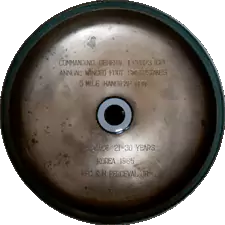

I Corps 5 mile race (1965),
Gene Perceval 2nd place


The company commander, during one of his daily announcements said that the general wanted three soldiers from each compound to volunteer for the "I" corps South Korean five-mile race. Myself and two others from our compound took a jeep to a place near Seoul (the capital) to participate in the race. We arrived a little late, and everyone was already lined up. There were several hundred Koreans and Americans there. I heard the gun go off when we were still at the other end of the parking field. So I took off, and I gradually started passing runners one by one. Not knowing who was first, I continued to run until I finished. After the race, I had no idea how I placed, but a week later, I found out when I was driven to the awards ceremony to receive a nice brass plate with the "I" corps emblem on it for winning second place.
I Corps 5 mile race (1965),
Gene Perceval 2nd place
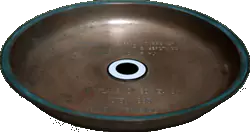

I Corps 5 mile race (1965),
Gene Perceval 2nd place


As a red belt
I kept moving along rapidly through my lessons with Mr. Chun. He and I continued to make frequent trips to other towns to martial arts schools where I did free-fighting and breaking, again which I enjoyed. There is a big difference between breaking bricks in Korea than in the United States. In the U.S., bricks are fired up in a kiln, which makes them harder. Back then in Korea, the bricks or tiles were laid out in the sun to dry, which made them more brittle. When you punched a stack of them they would break and crumble.
Giving back to the towns people
"Deuce in a half" truck
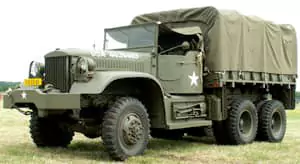

"Deuce in a half" truck


Using a Kutusa soldier to translate, Mr. Chun asked me if I could borrow a truck because the town wanted to build a church. They needed sand which was about twenty miles away. So I spoke to the company commander and he approved my request, again. I used a deuce in a half, which was a 3,500 pound load and slightly more. I drove the truck into town and picked up a dozen or so men with shovels. When we arrived, I backed the truck into the sand at the beach and the workers shoveled the sand high onto the back of the truck. When we finished, everyone jumped on the back of the truck. As I tried to drive away, the wheels spun. After spending some time trying to get out, I had sunk in deeper and deeper into the sand until I was close to the truck's axles. Luckily, in the far distance, I saw one of our army crane trucks on a dirt road. I ran as fast as I could on an angle to reach the truck while waving my arms. For some reason the driver seemed hesitant to help me, but after pleading, he helped us pull the truck out. We pulled the cable out of the winch and hooked it up to the truck. Luckily we were able to pull the truck out of the sand.
Before I left Korea, the townspeople had built the church.
The pot belly stove
pot belly stove:

At our compound, at the top of the hill, was a place where most of the guys hung out and bought drinks (a casual bar), or talked or listened to music. I happen to be a very light sleeper (extremely light). One of the guys that lived in the same Quonset hut as me liked to drink a lot (perhaps too much). There were no toilets in the huts, so if you had to go, you had to walk up the hill past several other Quonset huts to where the toilets were. As mentioned earlier, it gets very cold there in the Winter, especially at night. This one GI, when he was stone drunk in the middle of the night, would open the Quonset hut door just enough to pee outside. Naturally he woke me up every time he walked by my bed, to go pee outside the door. This happened several times a night, for a while. So I spoke to him, but he didn't seem to remember our conversation.
1st degree certification
signed by Hwang Kee
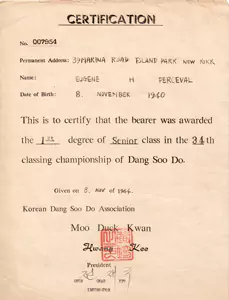

1st degree certification
signed by Hwang Kee


This G.I.'s drunken annoyances continued but in a more strange way. In the middle of the hut we had this pot belly stove, which was our only source of heat. The stove was located directly at the foot of my bed. Above my bed was a small window. More than once, instead of the G.I. peeing outside like he had been doing, he had now been peeing on the hot pot belly stove, which stunk up the whole place. As usual, everyone slept through it except for myself. After several times, I complained to the rest of the guys. The next time he peed, I turned on the lights and complained loudly, and he was finally caught. But that was not the end of it. Shortly after, during the middle of the night – while he was stone drunk (again) – and he must have been really quiet because I woke up thinking it was raining out – this GI was peeing on my blanket. While laying in bed, I kicked him so hard he fell over and bounced onto the next guy's bed and then fell onto the floor where he remained the rest of the night. When everyone woke the following morning, several of us approached the company commander and complained about his drunken pee antics. The outcome was that he had to move to a Quonset hut right next to the toilets, and that he was given a limit on how much alcohol he was allowed to drink. I wasn't pissed off, I was pissed on.
My first-degree test
Only one bus to Seoul;
most everyone walked


Only one bus to Seoul;
most everyone walked


From the time I was a white belt to the time I had tested for my black belt under Mr. Chun, all throughout he was learning English. And eventually, he learned enough English to where we were able to communicate better (using only a few words and some sentences). One day, Mr. Chun informed me that I was ready to be tested for blue (black) belt. We took the bus to Seoul, that came twice a day, in 1964, for my testing at Moo Duk Kwan headquarters, also known as Joong Ang Dojang.
Mook Duk Kwan
headquarters
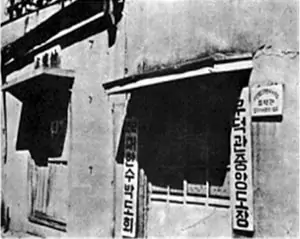
There, three of us were present for my black belt test: Grand Master Hwang Kee, who sat on a chair at the center of his school, Mr. Chun Chae Kyu who stood at the edge of the training floor to my left, and myself standing facing Grand Master Kee at the center. The headquarters was dimly lit. My test began by Mr. Chun calling out my technique requirements for first degree. After my testing, Grand Master Kee and Mr. Chun talked to each other for a while as I was still changing. Afterward, Mr Chun and I left headquarters to catch the bus to head back to town. I had considered asking Mr. Chun if I passed my test while sitting on the bus on our way back, but knowing better and following in line with martial arts etiquette, I refrained from asking him.
Grand Master Hwang Kee
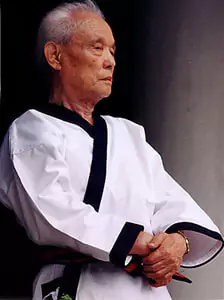

During my my next class on the compound, Mr. Chun came with my new belt, and my first degree black (blue) belt certificate.
My invitation to Mr. Chun's school
At the end of my first lesson on the compound as a first-degree black belt, Mr. Chun invited me to join him at his school in town, for the first time. He gave me directions to his school and the time to be there. I had arrived early. I walked around town on the dirt road for a while wearing my new uniform under my jacket, passing by Mr. Chun's school a few times to make sure I wasn't late. His school had the Moo Duk Kwan emblem above the door. To the right side of the door hung a white banner in Korean. The walls of the school were built just as the other stores on the block were: wooden planks nailed together side-by-side. The door was built the same way. When I slowly pulled the door open and peeked inside, I saw older boys and men in uniforms warming up and stretching.
Gene Perceval's 1st degree
certificate under Mr. Chun
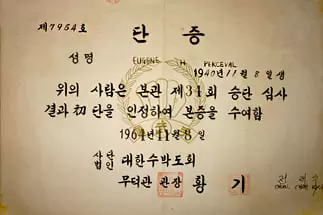

Gene Perceval's 1st degree
certificate under Mr. Chun


I stepped inside, bowed, and looked at Mr. Chun. He waved me in and pointed to the pile of jackets on the floor in the corner. For a school that was about twenty five feet by twenty five feet, the place was packed. The school had a dirt floor with a single light bulb hanging from its center. It also had a back door facing a small stream several feet away, which was used as a toilet. Upon entering the school, everyone stopped and looked at me, bewildered. I presume they were curious as to why I was wearing the same patch in addition to a black belt. I also remember feeling out of place; I was the only non-Korean there. Mr. Chun spoke for a moment (in Korean), then everyone continued to warm up and stretch.
Gene Perceval's 1st degree
registration card
signed by Hwang Kee


Gene Perceval's 1st degree
registration card
signed by Hwang Kee


Right before his class started, Mr Chun had the lower belts make a line and search for pebbles while the rest of us stood against the walls. The class was led by a third degree black belt. First, the color belts did their basic movements followed by combinations, then they did free fighting. The seven or eight black belts, not including myself, corrected the colored belt's movements. Because of the lack of room in the school, students took only a few steps forward and backwards. Still feeling out of place, I just stood there and watched next to the wall.
The class suddenly came to a stop
Mr. Chun spoke in Korean, and some of the students responded. Two of the black belts then left the school with their uniforms still on. The class then continued for about ten or fifteen minutes until the door opened again. In came two black belts – the ones who left before – with one extra person: a boy about seventeen or eighteen years old. He was wearing a red trimmed uniform and carrying his red belt. Mr. Chun sounded very angry. Apparently Mr. Chun seemed very annoyed with the boy. Mr. Chun instructed the boy to put on his red belt. The boy then bowed deeply to Mr. Chun. The boy immediately turned and faced towards one of the first degree black belts and began fighting him. Each one of the black belts (except for myself) took turns fighting the boy. The third-degree black belt was the last person to fight him. They beat him up so badly, he wasn't able to stand any more. At the end of the fight, the third degree black belt removed the boy's red belt, threw it to the dirt floor and ground it in with his foot in a show of disgrace. Of the two black belts who brought the boy back to the school opened the door while the other pushed the boy outside onto the ground, closing the door after him. I had no idea why they beat him up, but I found out later from one of the students in class who spoke a little English that Mr. Chun was allowing the boy to participate in his classes for free because the boy couldn't afford them, and apparently, the boy decided to just stop showing up to Mr. Chun's classes without telling him – which is considered bad martial arts etiquette.
This was my first experience in seeing how respect was taught among martial artists in Korea. It was also a lesson that was taught the hard way (the traditional way) in South Korea. Obviously today an instructor could never do this.
Continuing class after the boy was thrown out
Finally, it came time for the black belts to do their forms including myself. I did some three-steps and one-steps including some other techniques that the other black belts were doing.
Among all the black belts, only one was a third-degree, who was Mr. Chun's assistant. Among the others, were three second-degree's and a few first-degree's including myself.
Mr. Chun's colored belts
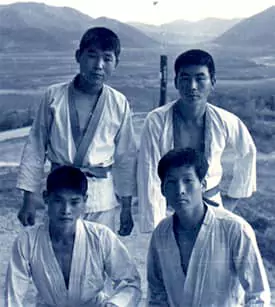

Mr. Chun's colored belts


Free fighting at Mr. Chun's school
My first match I was paired with one of the first-degrees. We bowed and did some free fighting. (As a guest in Mr. Chun's school, I was well aware that I was a new arrival and was being closely observed (by everyone). I made it a point not be taken advantage by any of his black belts. Likewise, I made sure my free fighting wasn't overpowering any one else either. I fought each of the first-degree black belts, then the second degree's. I showed my utmost respect toward each of them, making sure I wasn't winning or losing. The third degree also fought each of Mr. Chun's black belts.
Mr. Chun's black belts
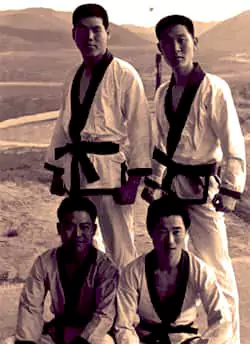

Mr. Chun's black belts


Finally, I was matched up with the third degree. The third degree and I bowed toward Mr. Chun, then toward each other. We took our fighting stances and began free fighting. He was more polished than the other black belts. His techniques were a lot faster. Both of us were cautious at first, doing lots of moving around, taking turns attacking and blocking (typical school free-fighting.) Then, Mr. Chun stopped our match and said something to the third degree black belt. We continued to free fight again. Very quickly I got the drift of what Mr. Chun said to my opponent because he suddenly started with a flurry of attacks, one which surprised me with a good kick to the stomach. Naturally, I stepped up the heat as well, doing what I do best: defending everything, even though my opponent got in a few times.
Gene Perceval,
at the compound
(in South Korea)
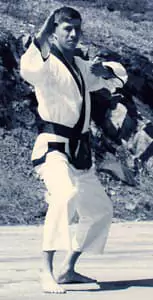

Gene Perceval,
at the compound
(in South Korea)


Since the style we were practicing "Moo Duk Kwan" didn't have any take-downs, I used this to my advantage. Each time the third-degree black belt kicked, I evaded and took his feet out from under him, taking him to the dirt floor. I also got a lot of good counter attacks in. After a while, Mr. Chun called for us to end the match. We bowed to each other and towards Mr. Chun. He then began talking to the class. As I stood there listening to Mr. Chun, I took a good look at my opponent and noticed his uniform appeared as though he had been rolling around in the dirt for a while. My uniform had only but a few dirt marks on it.
Gene Perceval,
at the compound
(in South Korea)
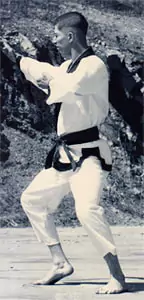

Gene Perceval,
at the compound
(in South Korea)


As Mr. Chun started speaking, the class turned in my direction. Soon I got the hint what Mr. Chun was talking about: I had previous years of experience in the martial arts training in the United States, and that I was his student, and that he had been training me at the compound.
Looking back, Mr. Chun planned this day out before he invited me to his school.
My lessons continued at the compound as they had before. A few times I returned back to Mr. Chun's school, each time I was welcomed. At the compound, Mr. Chun's black belts and myself worked out many times together. We practiced for upcoming demonstrations and other martial art affairs.
Mr. Chun and I in Seoul
Only one train station (1964),
Seoul,South Korea
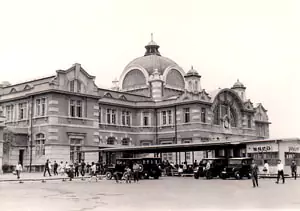

Only one train station (1964),
Seoul,South Korea


While I was in Fort Bragg during my Special Forces training, I had continually been making jumps from airplanes in order to keep my "wings." On a Friday, on November 22, 1963 after making my jump, I carried my parachute back to the meeting area where I was informed that President John F. Kennedy was just shot and killed. President Kennedy was very popular at the time and well-liked among the Korean people.
During the early part of 1964, not long after Kennedy was assassinated, Mr. Chun and I visited Seoul (the capital). As we were walking around Seoul, we passed the main Bank of South Korea. We stopped for a moment and looked at the bank's front window display. Sitting in the display was a large picture of John F. Kennedy and two half-dollar coins of John F. Kennedy. Both sides of the coin were shown and set on dark velvet, with one coin facing up and the other facing down. The display also had two banner descriptions: one in Korean, and one in English.
John F. Kennedy,
half-dollar (1964)
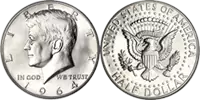

John F. Kennedy,
half-dollar (1964)


The Bank of Korea was displaying the very first John F. Kennedy (half-dollar) coins that the country received. Also on display was information about the president.
Later that day, upon my return to the barracks, I wrote a letter to my mother on Long Island asking for her to send me some half dollar coins of John F. Kennedy. Not long after, I received a handful of Kennedy half dollars coins, in silver, and gold-plated. During my next martial arts lesson, I presented one to Mr. Chun. He was very surprised.
An invitation to a Korean birthday party
One day after one of my lessons, inside the compound on the basketball court, Mr. Chun invited me to attend his best friend's birthday party. I accepted his invitation.
Birthday dinner table
(not actual table)
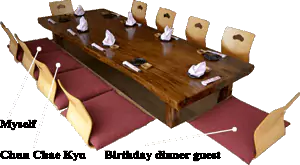

Birthday dinner table
(not actual table)


On the day of the party, Mr. Chun and I had taken a bus to the restaurant where the party was being held. Upon entering the restaurant, we were guided into a separate, closed, private room. Inside the private room were several gentlemen, standing there holding drinks and talking. Mr. Chun introduced me to them (speaking in Korean). Soon after, the rest of the party guests arrived. In total, there were ten of us. One of the guests suggested where everyone should sit. The table was rectangular and low to the floor. We sat on soft cushions. Four people sat at each side of the table and two guests sat on either end. The birthday party was for a gentleman who sat at the far end at the head of the table. I sat at the furthest point from the birthday person next to Mr. Chun. Throughout the party, everyone spoke in Korean. I didn't understand a word they were saying but I listened as though I was part of the conversation.
Drinks came and then the food, and – the food just kept coming. The conversation continued through mealtime, which seemed to last forever. I remember thinking to myself: why did I accept this invitation to the party in the first place? I had been sitting there for hours, feeling bored, not able to understand a word being spoken. Finally, when the conversation paused momentarily, I nudged Mr. Chun and showed him a small package I had wrapped, which was a gift for the birthday person. Mr. Chun spoke and my gift was passed down. As the birthday person gently opened it he looked up at me several times. Inside the gift was a gold-plated John F. Kennedy half dollar coin. Mr. Chun explained to everyone that the coin was the same version of the one we saw in the bank window, in Seoul. The birthday person thanked me, and smiled while nodding his head. Then everyone took turns passing around and examining the half dollar coin.
Most towns outside Seoul,
had no running water.
Water wells were used instead.
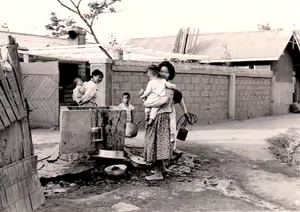

Most towns outside Seoul,
had no running water.
Water wells were used instead.


Then, the gentleman sitting on the other side of the table next to the birthday person, spoke in perfect English and said, "everyone is interested in your studies of the martial arts in New York." Up until that moment, I was not aware that anyone at the party spoke in English. Our conversation was translated back and forth from Korean to English. I was asked a lot of questions, such as: "How long have I been training?" "What types of martial arts had I studied?" "Who were my instructors?"...And so on. Most of the questions asked of me were about the schools I had trained in. "Did the government control our schools? and, can anyone open a new school?" "What were the cost of lessons?" Anything and everything pertaining to teaching martial arts and owning a school (business related) were asked of me.
After four hours of food and conversation, everyone said their good-byes and left. It was dusk.
Was it really a birthday party?
Was this really a birthday party? I wasn't so sure after leaving the party. When something didn't make sense, I always ask questions. Why did Mr. Chun invite me to a dinner with his friends when none of them spoke English (except for one)? Was this person who spoke English asked to attend the dinner because he spoke perfect English, in order to translate for me? (Which by the way, Mr. Chun never explained to me the real reason for inviting me to the party). And why did Mr. Chun let me sit there for several hours while I was being ignored? And why did everyone near the end of party ask so many questions about me and my martial arts experience, and about operating and owning a school? Before leaving for home (back to the United States), the pieces of the puzzle finally came together, and I finally saw the real story in the events that had unfolded.
A gathering of all different Korean styles into one: to become Tae Kwon Do
My tour in Korea was shortly coming to an end. Mr. Chun had informed me that soon I would be taking my second-degree black belt test, in Seoul, Korea. I was prepared and excited for the test, but not nervous.
When my testing day arrived, Mr. Chun and I took the bus to Seoul, which may have been a Saturday, but I believe it was a Sunday on April 18, 1965. (The actual day was not specified on my diploma). When we arrived at the testing building in Seoul – on the outside of the building I saw young boys jammed together looking in through the windows. Upon entering the building, I noticed it was packed with a lot of martial artists from different systems, most wearing color belts, all sitting on the floor close to each other. I knew this by the system patches everyone was wearing. The building wasn't as big as it should have been for the amount of people in it (which were all men). And I'm not positive but it looked like the South Korean army, Tiger System was there by the looks of their patches.
Once everyone was situated, Mr. Chun disappeared behind a closed door. At the far end of the room was the Dias (tables) lying next to each other with chairs underneath them, which could have seated about twenty people (I didn't count them all). Of all the martial artists present in the room, there were only two of us that were black belts. The other black belt was a Korean man who didn't speak English. He wore two stripes on his belt. The two of us remained standing for warm-ups and stretching. After a while, the door opened and the testing board took their seats at the Dias. Mr. Chun was not seated at the Dias but seated alongside the wall. Everyone then stood for the flag and the national anthem. Afterward, someone spoke for a short while, first in Korean, then in English.
Continuing: The beginning of Tae Kwon Do; How Tae Kwon Do got started
General Choi Hong Hi
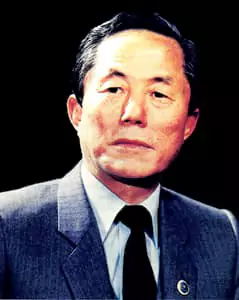

General Choi Hong Hi


The second-degree black belt and I were the first to be tested. The second degree black belt was going for third degree, and myself for second. The second-degree performed a few basic techniques, some combinations, and a form. During his testing, I stood on the side and watched. Meanwhile, I took a good look at who was seated at the Dias. Behold! In the very center of the Dias was the same gentleman who was at the dinner table from the birthday party I had attended. This gentleman was the same person whom I gave the John F. Kennedy half-dollar to at the dinner party, General Choi Hong Hi, the founder of Tae Kwon Do.
When it was my turn to test, I performed the same routine as the second degree black belt. When finished, I was asked to remain in place. Because so many of the high ranking black belts present that day [from different systems] who were not at the birthday party, they also asked me the same sort of questions that were asked of me during the party, which lasted for about five minutes or so. I assume they were verifying with other high ranking people about the possibilities of spreading and developing Tae Kwon Do schools to become the largest system in the world. After this event on April 18, 1965, all Korean systems at the time were merged together, becoming "Tae Kwon Do," making Tae Kwon Do the largest system in the world. In other words, black belts coming from various Korean systems, were consolidated into one Korean system: the Tae Kwon Do system.
Moo Duk Kwan patch
(I had hand-made, 100 of them,
in South Korea)
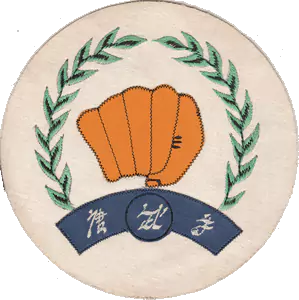

Moo Duk Kwan patch
(I had hand-made, 100 of them,
in South Korea)


Some of the other major Korean systems present that day (during my testing) that became part of the Tae Kwon Do system were: Jido Kwan, Chang Mu Kwan, Chung Do Kwan and Song Mu Kwan. Within those schools existed even more sub-schools. For me to maintain my original system, "Moo Duk Kwan" – which I made my first degree black belt under (founder Kwan Kee) – my system would have to be combined with the newly formed "Tae Kwon Do" system, making it "Tae Kwon Do Moo Duk Kwan" system.
The Koreans were smart to consolidate all different Korean systems into one system "Tae Kwon Do," because having one vast system – a system which encompassed all the smaller Korean systems – would form the largest martial arts system in the world.
Continuing with my second-degree black belt test
After answering questions, I remained on the floor and waited for the second-degree black belt to approach the floor. We both bowed toward the high ranking black belts and towards each other. First, we demonstrated some escape techniques, a few self-defense techniques, three step attacks and blocks, fast one-step blocks, and then counters. Finally, we free fought each other. We were evenly matched. I didn't perform any of my favorite fighting movements such as sweeps and counters during our free fighting because the Korean stylist's never adopted them into their free fighting (for some reason).
During the time of my testing, I didn't realize the importance of this event, particularly as it related to the overall development of Tae Kwon Do as a system.
I never knew about the ranking system in Korea
Master
Chun Chae Kyu


Master
Chun Chae Kyu


When I took and passed my second-degree black belt test, not only did I move up in rank but so did Master Chun, my instructor. This is how the ranking system worked in Korea in the mid 1960's. Back then, each time a master tested a student to become a black belt or promoted a black belt to the next rank (after the master certified one hundred black belts), the master is eligible for promotion himself. For example, if a master had two first-degree black belts, two second-degree-black belts, and two third degree-black belt students, that equals a total of [1st dan = 2], [2nd dan = 4], [3rd dan = 6]. In total, that is equivalent to six black belts credited toward the master's one hundred black belts. As part of the Korean's rules, sufficient time and grade between each of the master's ranks was required in order for him to have moved up in rank.
2nd degree certificate;
The day Tae Kwon Do
became a system
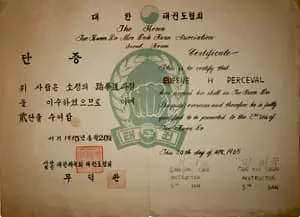

2nd degree certificate;
The day Tae Kwon Do
became a system


And for the master to have attained the next highest rank, he would have had to start from zero again, up to one hundred with the next set of students. After I passed my test for second degree black belt, Master Chun reached his one hundredth total recognized black belts. As a result, we both were promoted and moved up one rank that day.
My eighteen-month tour in Korea
In Korea, I was fortunate enough to have a discerning (good judgment) company commander who gave me all the time I needed to pursue my martial arts training. Before Korea, I had nine years of martial arts experience. After Korea, I left as a legitimate second-degree black belt (Bon number: 7954) in my eighteen month tour. This was the normal time that a typical U.S. Soldier was stationed in Korea.
To be a black-belt, or to not be a black-belt, that is the question
I personally felt there was an injustice done to the American service men who toured Korea for those eighteen months who made first-degree black belt. The standards and requirements for American solders who tested for black belt in Korea were different than those for Koreans (people who lived there). In other words, Korean instructors knew that American soldiers were only there (in Korea) for eighteen months and therefore, tested them for black belt within that time period. When a Korean (resident) martial artist made black-belt, it took much longer [obviously] because they were not under any time restraints. I became aware of this after befriending one of Mr. Chun's black-belts. American military service men who made black belt in Korea, after returning home, must of had a rude awakening when matched against a traditional martial artist – someone who attained black belt with no time restraints – because the traditionalist had much more experience compared to someone of equal rank.
The conclusion of my experience in Korea:
To be tested directly under the founders of two systems, Grand Master Hwang Kee of Moo Duk Kwan system (my first degree black belt), and Grand Master General Choi Hong Hi of Tae Kwon Do system (my second degree black belt), was a very rare and unusual experience. To be tested by both founders was a great honor, and I greatly appreciated my instructor, Master Chun Chae Kyu, for having made that possible.
Returning back home to the good old U.S.A.
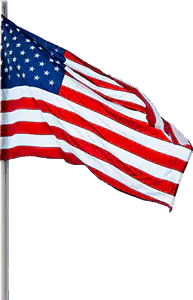
Upon my return to the United States, I reported back to Fort Dix, New Jersey to finish my military obligation. However, during my enlistment, I chose the Orient as my location instead of choosing a job occupation. As a result, I was assigned as a cook at Fort Dix (which I never really did any cooking). At the Fort, one of my main jobs was to supervise new recruits in the mess hall as a Kitchen Police (KP). The army made a good choice by not letting me cook because they needed their soldiers to remain healthy. The Kitchen Police job gave me plenty of spare time to myself. I even had my own room in a new building and things couldn't have been better.
Training at Ft. Dix's main sports arena
When I was off duty, sometimes during the day – but always in the evenings – after Kitchen Police I went to the main sports arena to work out for several hours by myself. I practiced in an area where I didn't interfere with other people playing basketball or in other sports. At the arena, there was a raised boxing ring (similar to what you see on television). Oftentimes I drew attention among others while practicing there, especially doing forms. Other times, I was approached by military men who asked me questions (regarding the martial arts), or sometimes they wanted me to demonstrate or show them how to do a little of this, or a little of that, which I always enjoyed. Occasionally, if another martial artist stopped in, we usually talked or worked out together. Not often did I meet other black-belts. And if I did, he was usually a Japanese or Okinawan stylist. I was approached many times during my training sessions and asked if I could start a martial arts class. This continued for a while until one day, a captain took interest in my training and asked me if I could teach, providing that I didn't accept any payment or money. So I agreed. And he made arrangements for me to teach at the arena. He ended up becoming one of my students.
Teaching at Ft. Dix main arena
Training at Fort Dix, in the sports arena
(Gene Perceval to the right in photo)
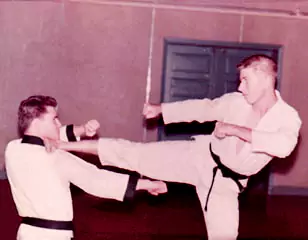

Training at Fort Dix, in the sports arena
(Gene Perceval to the right in photo)


There was a constant influx of boot camp trainees and regular service men personnel who were permanently stationed at Fort Dix. There were also military personal in transit nearby from the McGuire air force base, which was right next to Fort Dix. Both bases (Fort Dix and McGuire) had dependents: sixteen year old's and older, who had use of the gym at Fort Dix.
Once my martial arts class started at Fort Dix, word passed around like wildfire that I was teaching at the gym at Fort Dix. During my first class, I had a handful of students. The next class I had maybe thirty students. Within a two-week period there were over seventy-five students in my class.
Teaching martial arts class
at Fort Dix (1965-66)
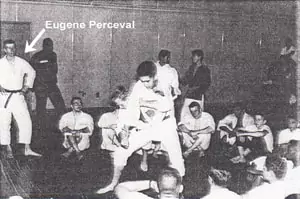

Teaching martial arts class
at Fort Dix (1965-66)


It was impossible for me to teach all of them at once on the floor (because they all couldn't see me), so I stood on top of the boxing ring and taught. My classes dwindled down to perhaps twenty or thirty students because I felt it was best for my regular serious students to learn properly and focus on them, rather than teach students who were only there for leisure.
Why I formed my own style at Fort Dix
When I returned from South Korea, I was as a Tae Kwon Do Moo Duk Kwan stylist, and decided to keep that style, so I continued teaching it at Fort Dix. As my students moved up in rank, I wrote to my instructor, Master Chun, telling him about my student's progress. I told him about how I was testing students for black belt following the Tae Kwon Do Moo Duk Kwan system.
Diploma I made for my students
at Fort Dix (1966)
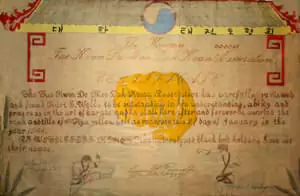

Diploma I made for my students
at Fort Dix (1966)


I also informed him that each of my students received my class-student number along with their diploma (which I made myself). I hand drew each individual diploma. Also in my letter, I had asked Master Chun about how I could advance in rank, being that I was the first person in the United States to teach the Tae Kwon Do Moo Duk Kwan system. I didn't receive a return letter from Master Chun. So I decided that it was best for my students and I to cut ties with South Korea and go our own separate ways. As a result, I started the "Tae Kwon Do Moo Duk Kwan U.S.A." System. A few years later I learned that Master Chun had changed his address and that he never received my letters.
I accepted one non-military person in my class
While I was in my room at Fort Dix, I received a phone call from a man named Mr. Raymond Gay. Raymond said he was a martial artist and lived about forty five minutes away. He also mentioned he had heard about me and was wondering if he could stop by and watch my class, and talk with me afterward. So I agreed. When Mr. Gay arrived, I was in the midst of teaching a class so he went directly over next to the boxing ring close to where I was teaching, and he leaned against it, and observed my class until I had finished teaching. Afterward, he introduced himself to me and mentioned he had been studying the martial arts for several years and was currently a brown belt (mixed systems). Raymond also said he had outgrown the knowledge and skill level of several of his instructors and wanted to learn more. So I agreed that he would participate in my class and would be the only civilian permitted. Eventually I certified Mr. Raymond Gay as a black belt.
Grand Master Raymond Gay
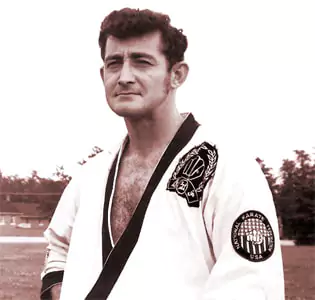

Grand Master Raymond Gay


When my enlistment services were finished at Fort Dix, I moved back to Long Island.
During my time at Fort Dix however, when my students made black belt, I gave them a choice: to either remain with me, which would be difficult because I lived two to three hours away on Long Island, or study under as many instructors as possible and learn everything they could. And perhaps one day they could develop their own style and system in the martial arts. And that's exactly what Raymond Gay did: he founded the "Kenpo Black Cat" System, located in New Jersey, which is currently on its way to producing one thousand black belts. There is much more to be said about Grand Master Raymond Gay. But he and I remained good friends until his passing in 2015. If Ray lived in Japan a hundred years ago, he would have been a Samurai, without any doubt in my mind.
The National Karate Federation
The National Karate Federation started on the East Coast of the United States in the early 1970's. The Federation covered New York, New Jersey, Connecticut, and parts of Pennsylvania. It was founded by numerous American martial artists who had many years of experience, some with decades of experience including myself. Some of the Federation's martial artists were first generation black belts certified by instructors who came directly from the Orient, while others had lived and trained directly in the Orient. Additionally, some members also decided to form their own style and system like I did, back in the 1970's, that I called "Tae Kwon Do Moo Duk Kwan USA."
In the 1970's, one of the main issues first-generation martial artists such as myself had with other non Federation martial artists was that they were proclaiming ridiculously high black belt ranks. One day I would see a first-degree black belt, the next time I saw them, they were masters. Ranking was getting out of hand in the early 1970's. We wanted to expose the frauds and publicize their names along with their schools – which were opening up all over the place – so they wouldn't cheat their students. However, we were advised that exposing them would land us too many law suits, so we never pursued.
Gene Perceval front cover;
(with Forrest B.)
Official Karate Magazine
(May, 1973)
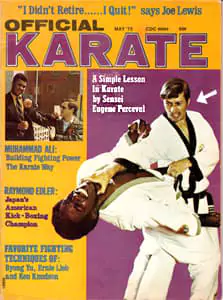

Gene Perceval front cover;
(with Forrest B.)
Official Karate Magazine
(May, 1973)


During that same time period, in the 1970's, the Tae Kwon Do system that was formed in South Korea in April 1965, was continually becoming more unified and stronger. The National Karate Federation was improving in this regard as well. American instructors found that there was a better future for them and their students in The National Karate Federation because of the amount of members we had. We controlled the tri-state area among martial artists. The Federation did a lot to promote martial artists, and also promoted the martial arts in our area. Schools were filling up with students because of The Federation. The Official Karate Magazine went wherever martial artists from The Federation went, because of our popularity. Most of us from the Federation were on the cover of the Official Karate Magazine at some point (including myself – see photo).
Some of our masters were even in the movies.
Unfortunately, American martial artists found themselves stunted in rank however, when Oriental instructors promoted them in rank. In other words, Oriental martial artists were continually advancing in rank while American martial artists weren't under Oriental instructors. This is called the "martial arts glass ceiling." The glass ceiling is an invisible barrier that keeps non-Oriental martial artists from rising beyond a certain level. Because of this barrier, I was frozen in rank as a second-degree black belt for eight years. However due to the strength of the National Karate Federation, they were able to promote me to Master, fourth-degree through a vote, which was based on the fact that I was producing black belts, and had been a second-degree black belt for way too long.
September of 1972: New Jersey State Fair, Karate games
National Karate
Federation patch
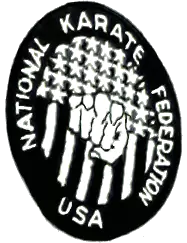
One of my black belt students, Forrest B., was approached and asked if he was interested in organizing the first Karate demonstration and competition at the New Jersey State Fairgrounds. He and I were members of the National Karate Federation at the time and had more than enough black belts to participate in the competition, so Forrest agreed. The event itself was also open to any martial arts school that wanted to join. The New Jersey State Fairgrounds competition was held in Trenton on September 8th to 17th, in 1972. The Olympics was only a few years away and with the help of the National Karate Federation running the demonstrations and competitions at the fairgrounds, our participation would help promote the Amateur Athletic Union of the United States. And with over one million people attending the fairgrounds each year, the event expanded the martial arts to all those who attended.
For competitions at New Jersey State Fair, we set the rules. All referees had to have at least eight years of experience in the martial arts and attained at least a third-degree black belt or higher to referee the fairgrounds competitions.
(In picture) of Grand Master Raymond Gay – on his uniform, you will see a patch that says, "National Karate Federation" (all members wore on their uniforms).
Live on stage: "The 1974 World of Kung Fu"
Joseph A., a black belt and a promoter, came up with the idea to put on a martial arts stage show. So he selected seven of what he believed to be some of the best schools in the tri-state area (which included NY, NJ, and CT) to participate. A meeting took place between him and the selected school owners. Each school agreed to produce a performance for the show. The show was called, "The 1974 World of Kung Fu." Its title was chosen by Joseph A., the producer. The show was held at the War Memorial Auditorium in Trenton, New Jersey in 1974. I don't know why Joseph chose "Kung Fu" to be in the title of the show since there weren't any Kung Fu practitioners in the show. I assume his decision was based off of the popularity of a television series at the time called "Kung Fu" (which aired from 1972 to 1974, with David Carradine). The contingency for putting on the show (according to Joseph) was that if it became popular or a hit, then there wouldn't be any restrictions about where the show would lead to, including Broadway or movie contracts.
"The 1974
World of Kung Fu"
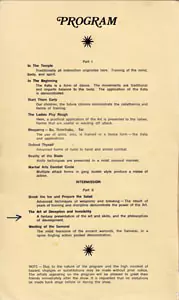

"The 1974
World of Kung Fu"


The promoter (Joseph) asked each of the seven schools to come up with a theme for their individual performance for the show, and a name for each of their performances. I was part of Forrest B.'s school. Forrest B. was my student. We had only a month to prepare for the show. Every weekend for very long hours we rehearsed at Forrest's school in New Jersey. We had a cast of around twenty people. They were black belts, students, and others who just wanted to participate in the show because they were friends and family of the cast (who were stagehands).
During rehearsals, I was surprised to learn that many of us had hidden talents. We had artists, musicians, script writers, and just, talented people who helped make our production an entertaining success.
"The 1974
World of Kung Fu"
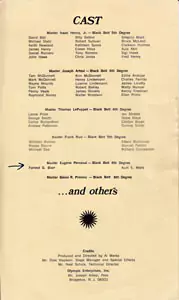

"The 1974
World of Kung Fu"


None of us knew what each of our school's performances were until the day of the show when we watched them live in the audience, except for Joseph, who had stopped in to see our school's rehearsals prior to the event.
Joseph did all the marketing and advertising for the show. Therefore he received a percentage of all the box office tickets sold. The deal for doing the show was that if all seats were filled, each school would walk away with thousands of dollars. And this would be incentive for us to continue performing at similar events in the future.
"The 1974
World of Kung Fu"
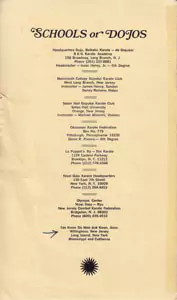

"The 1974
World of Kung Fu"


Shortly before the start of the show, Joseph informed me that our school was performing last. (Note that the playbill shown in the pictures shows our school performing second-to-last when indeed our school actually performed last). Joseph also said that there would be a short intermission before our performance. This gave us enough time to set up all our equipment.
Finally, it was the day of the event. Our school was the first to arrive at the War Memorial Auditorium. Other schools had shown up shortly after us. We didn't have time to rehearse immediately before the show, but we knew our parts. We had unloaded a lot of gear. The stage setup for our performance was quite elaborate. For our set up, we placed a half dozen four foot long florescent blacklights along the floor at the front part of the stage near the stage's edge. We also assembled an eight foot high Buddha (that we made in sections) and placed it on the right side of the stage facing on a slight angle. Also, stage props were scattered about, giving the stage the appearance of being inside a Buddhist temple.
War Memorial Auditorium,
Trenton NJ


Right before curtain time, we had looked out into the audience and expected to see how packed it was. Unfortunately, we were greatly disappointed to see that only about a hundred people had shown up. Most of them were family and friends of the cast. At a later date, we found out that Joseph (the promoter) was not thorough about promoting the show and had only put up posters to advertise.
The first school that performed used weapons during their act, and they did some fancy self-defense movements. Their performance was good, but not what I would call a "stage performance." It was more like a typical demonstration one might see at a martial arts tournament. Other schools basically did the same thing: they put on "demonstrations," except each demonstration had various types of attacks and defenses. I had expected to see a greater use of creativity in each of their performances particularly from my martial art friends, however, I was somewhat disappointed.
Master Thomas LaPuppet
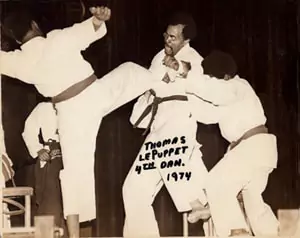

Master Thomas LaPuppet


Master Thomas LaPuppet's school, the second to last act, performed before ours. Master Thomas played the part of an old, blind martial arts master who wore dark sun glasses and needed a cane to walk. His performance started off with him walking across the stage very slowly, as he was being attacked by different assailants. Some assailants had weapons, others didn't. He walked his way across stage until he finished at the other side. Of course his character survived the whole ordeal.
Master Thomas's performance was entertaining. However, his assailants all wore karate uniforms instead of street clothes. More importantly though, his performance had a plot and a storyline, whereas other schools didn't (except for ours). During the initial meeting of the show when the seven school owners convened to receive details about creating their performances, I recall Joseph A. making it clear that the show was a stage performance, and not a demonstration. More particularly, each school advised Joseph A. about their presentation several weeks beforehand leading up to the show. Why other schools put on demonstrations and not a performance, I don't know.
As our school was bringing in all our equipment into the auditorium for setup, other schools were doing the same thing and they had also noticed the amount of equipment we were bringing in. Because of that, all the other schools in the show had taken seats in the audience when it came time for us to do our performance.
There was a short intermission right before our school went on stage. Our school was the last act.
As the audience returned to their seats, soft Oriental music was playing in the background as well as the chants of Buddhists monks.
We put the entire show's sound effects on a pre-recorded tape, including Forrest B.'s voice speaking in soliloquy so we wouldn't have to use a microphone. Each of us knew our parts well based on the audio being played.
After the audience was seated, Forrest B. – a man with great speaking voice on tape – started narrating the events of the show as they unfolded. Meanwhile the audience still heard Buddhists chants and music playing in the background. The lights then slowly dimmed until the auditorium became a sea of darkness. (The audience saw only what was in white or florescent in color). Our stagehands dressed in all black and had worn black masks so they couldn't be seen by the audience.
Gene Perceval, center stage
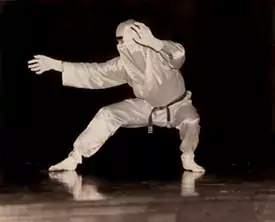

Gene Perceval, center stage


The stage curtain opened, and the only thing the audience saw was me standing there, centerstage, still, in a crouched position, wearing a glowing ninja outfit. Behind me was Kurt W. and Forrest B. wearing the same ninja outfit I was, but they were invisible to the audience at that time, because black sheets were raised in front of them by our stagehands. Then slowly, while still standing centerstage, I extended my body and arms outward while turning slightly, simulating the pushing of energy outward and away from me. Forrest B's voice on the audio tape was explaining that I was a "spirit" within us.
Gene Perceval and Kurt W.
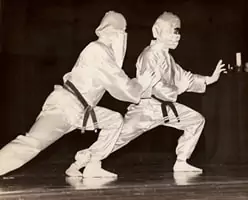

Gene Perceval and Kurt W.


Then quickly, the black sheet behind me hiding Kurt was suddenly dropped, giving the audience the impression that Kurt had suddenly appeared behind me. Kurt then stepped out further following the same sequence of steps and movements I had. The purpose of his physical appearance (which was being narrated on tape) was that, he was as an extension of myself, existing as the human mind – and I was the human spirit. Meanwhile, the music and chanting continued.
Another black sheet was then dropped, behind Kurt, this time exposing Forrest to the audience. Forrest proceeded forward on stage the same way Kurt and I had just done. Forrest represented the human body, an extension of the mind and spirit. Slowly, all of us began stepping away from each other, moving in perfect harmony with one another performing a choreographed Kata, or in Korean called a "Kyung." It was a set of movements resembling a combat situation. At the same time, the audio tape narrated the idea that the body, mind, and spirit are all in perfect harmony with one another, and that us three ninjas marked the presence of that notion: we all existed together as pure energy, in the form of human movement. When the sequence was over, we ended up exactly where we started off: behind one another, but still visible to the audience.
Prop of the Buddha –
Gene Perceval
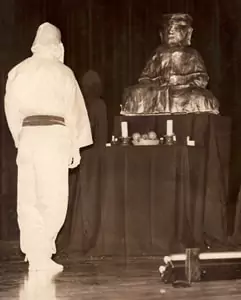

Prop of the Buddha –
Gene Perceval


A black sheet was then raised, hiding Kurt and Forrest from the audience. At that moment, from centerstage I walked over to the prop of the Buddha and bowed. Suddenly, a black sheet was raised in front of me, hiding me from the audience. At that time, the Buddha prop was removed along with other stage items leaving the stage completely empty.
Moments later – the audience still staring at an empty stage with only the blacklights shining – the music transitioned to a louder, fiercer, more war-like sound. At the same time, stagehands raised a black sheet spanning across the curtain line as Forrest positioned himself behind it, much further back, holding a weapon in hand, invisible to the audience. (Forrest B. was the higher jumper among us three, so he was chosen for this sequence). While still in concealment, and facing the audience, Forrest quickly ran towards the black sheet. He then jumped as high as possible, and at the height of his jump the black sheet in front of him was quickly dropped, making it seem as though he appeared out of nowhere in midair. The audio tape then put out a loud blood curdling scream as he landed. Immediately after, Forrest continued running towards frontstage where he crouched down at the stage's edge. He looked around slowly and menacingly, holding his weapon in hand as if he was about to attack. He then turned around and ran back towards backstage, leaping high into the air again. As he reached the height of his jump, a black curtain was raised again behind him at the curtain line, giving the audience the appearance he had suddenly disappeared.
The next scene
Just prior to the show we had hung a half dozen thick Styrofoam cut outs of life-like painted assailants from the ceiling which were raised about ten feet off the ground positioned in front of the back curtain. We then concealed them with a black cloth.
The scene opened with a dozen cast members standing on stage dressed in old traditional Japanese outfits reflecting off the blacklights. They were scattered around the three of us ninjas: myself, Kurt and Forrest.
Suddenly, all of the lights were turned off, and the music stopped. As the audience sat in complete darkness, they heard soft drums starting to play. Gradually the drums got louder and louder until the audience felt them pounding in their seats. The blacklights were then turned on. Meanwhile, ninjas dressed in black (invisible to the audience) and holding weapons started sneaking their way down both the isles in a crouched position.
Just as the first ninjas reached the bottom of the stage, the blacklights were turned off and the house lights were turned on again, exposing the crouching ninjas at the foot of the front of the stage. The ninjas then gradually worked their way towards the steps on either side. All of us on stage started moving closer as well, slowly approaching the ninjas. Suddenly, the music changed from pounding drums to upbeat music and a fierce fight scene pursued. The scene lasted for a while. The audio tape of Forrest B.'s voice continued narrating everything that was going on, of the different battle scenes. The ninjas fought each other in sequence to the music. At the end, many played dead from both sides, while a few remained standing, scattered about the stage.
The house lights were turned off again and the florescent lights turned back on. The Styrofoam ninjas still hanging from the ceiling were revealed to the audience. I made extra-large throwing stars called shuriken's out of thin sheet metal, to be thrown at the hanging Styrofoam ninjas. I made about a dozen shurikens. Each one was about one foot in diameter.
Kurt W. made his way from the back isle to frontstage until he was within throwing distance of the hanging ninjas. As Kurt moved within throwing range, he began throwing shuriken's at the ninjas. The last shuriken hit one of the ninja's on a slight angle and fell, striking the wooden floor, sticking right into it (as it wobbled). Someone from the audience had yelled, "they're not fake!" And at that moment, the show ended. Each of the players presented themselves on stage again in the order in which they played their parts. The stagehands also came out and unmasked themselves to be seen by the audience. We got a standing ovation.
The performance was an entertaining success and couldn't have been made possible without all those who helped including our stagehands (all ten of them) – one in which, who eventually became my wife.
The secret to a happy life is doing a job well-done, and knowing it was the best job you could have ever have done.
Entering into one of many Karate tournaments
Because of the popularity of the National Karate Federation, Karate tournaments were being held almost every weekend somewhere. Whenever black belts from the National Karate Federation went to tournaments, a photographer, Joe Griffith, from the Official Karate Magazine followed them (us). I had always made it a point to go to Karate tournaments. Usually I entered as a judge or referee.
During one particular Karate tournament in Bathesda, Maryland, black belts from all over the tri-state area from the National Karate Federation were invited to enter. I was the only Korean stylist at the tournament (which was a very large tournament). The rest of the competitors were either Japanese or Okinawan stylists. I was usually matched with one of their more popular martial artists.
Double Jump Back Hook Kick –
executed by Gene Perceval
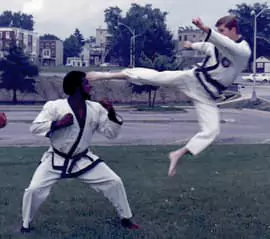

Double Jump Back Hook Kick –
executed by Gene Perceval


During one particular match, I saw an opening and did a spinning wheel kick to my opponent's head, missing him by inches. The matched was immediately stopped and officials warned me that those types of kicks were not permitted because they were not familiar with them and were concerned with me making contact to my opponent's head, particularly when the referees thought my kicks were blind-sided when they weren't. I then threw a front back hook kick at my opponent's head using the back of my heal, stopping just an inch or two from hitting his head. Officials had warned me a second time. After that, my opponent made it a point to keep his distance from me as I threw one kick after another at him being extremely careful not make any head or facial contact. However, after one more warning from the center judge, after doing another kick, the judge disqualified me. The National Karate Federation black belts immediately took my defense and said that the rules in the tournament's handbook did not specify against the use of my kicks as long as I didn't make any head or facial contact, which I didn't. The Federation protested that I should not be disqualified from the competition. Everyone argued back and forth for a while. The Federation asserted that I had fought in many competitions before and that this was the first time anyone had ever objected to my style of fighting. Being that I was a competitor, it was against tournament rules for me to partake in any disagreement during the competition. Then, a representative from Official Karate Magazine stepped in; they made it known that the tournament would be covered in next month's issue, increasing the pressure for them to withdraw my disqualification. The National Karate Federations proclaimed that if my disqualification were sustained, then all the competitors from the Federation would walk away from the competition, therefore leaving them to a tournament with a lot less competitors which would have been bad press for the tournament. Being that the tournament was being included in the next month's issue of Official Karate Magazine, the official's hands were tied: either lose a substantial amount of competitors resulting in bad press, or allow me to continue fighting in the tournament. The officials decided to let me continue fighting in the tournament; they had no choice.
We just wanted the officials to enforce the rules properly in accordance to the rules they set forth.
I was then matched against another opponent. This time, The National Karate Federation insisted that two of our senior masters be side-judges. The outcome of that match was that I had scored and won. At the end of the tournament, we all left and headed back home.
The events of this story were published in the 1973 Official Karate Magazine. I was on the front cover.
I moved back to Long Island, N.Y. and opened a martial arts school
My first martial arts school:
"Black Belt School Of Karate"
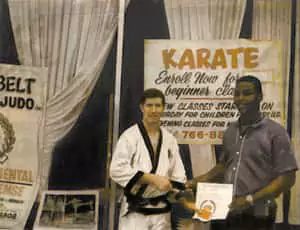

My first martial arts school:
"Black Belt School Of Karate"


It didn't take long for me to get back into the swing of things. I started visiting a lot of karate schools and instructors on Long Island. Eventually, a lot of them invited me to work out with them while they were teaching their classes, and sometimes have me teach some of my techniques to their students. During that time I was meeting a lot of new people.
One day I was approached by a red belt (one grade below black belt) who was a business owner. He was interested in opening a karate school and needed a black belt to teach at the school. So I agreed, and went into business with him. There had been another person who came in with us, a first-degree black belt. His name was Marvin S. The three of us opened the "Black Belt School of Karate." The red belt worked the front desk signing up new students while Marvin S. and I taught. Soon, our classes were full. Back then, we charged thirty dollars a month for unlimited classes.
Not long after the school opened, Marvin S. started missing some of his classes. As a result, I filled in for him. Marvin was supposed to teach half of all the classes, but over a period of time, I ended up teaching eighty percent of all the classes (which I really didn't mind because I loved teaching). But the issues with Marvin S. compounded. He was teaching differently than I was, even though the techniques we were teaching were the same. This became a real problem for our students because they were getting confused. Marvin taught more street-like movements while I was teaching more technically. Also, parents were not too pleased with the fact that their children were learning street fighting.
Soon after, Marvin S. moved to California without telling any of us.
Problems in our school worsened. The red belt, my partner, got a pistol permit and as a result, on occasions before or after class while he was working the front desk, he took out his pistol and flashed it in front of our students. Word eventually got back to me about this. He was also doing other things that displeased me that I eventually found out about (that I don't want to get into here). So I left the school. The red belt wanted to keep the school open even though he was the only business owner left, so he decided to put on a black belt and teach. Shortly after however, the school closed.
Interesting but true story
Warren M.
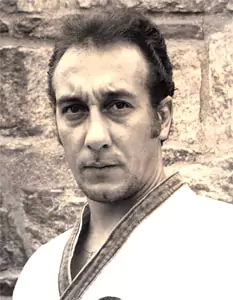

Warren M.


Warren M. and I grew up together as teenagers in Island Park, which was a very small beach community on Long Island back in the 1950's. And like many small towns in America, most of us knew each other. Warren was an avid body builder (as I remember him). He stood about five foot four and had a big barrel chest and arms to match. I had always admired him and his dedication to lifting. When we were younger, Warren mentioned he wanted to learn the martial arts with me, but he chose bodybuilding instead over the martial arts.
Years passed. Warren married in 1960. He had two little girls. At that time, Warren approached me and asked me if I could teach him the martial arts. His wife Kathy, had belonged to a bowling league. She went bowling for several hours on Tuesday and Thursday nights. While she was away, Warren stayed home while his two little girls slept in their bedrooms while I gave Warren martial arts lessons in his living room. We moved some furniture around to make room but space was still limited, so I taught him mostly close combat techniques. No Judo throws, but we did do grappling techniques on the rug. We also did a lot of wrist locks and arm bars, which is when my Aikido training came in handy. Karate was also limited to short bursts and a few kicks. All in all, we covered a lot, especially real street fighting situations. I was at his house faithfully twice a week until June 1963, when I enlisted into the military.
When I completed my military service in 1966, Warren and I re-connected and I continued teaching him at different locations. My techniques changed as well – my movements became more polished. While stationed in South Korea, during my martial arts training with my instructor Chun Chae Kyu, a lot of emphasis was placed on learning different types of kicks (which the Koreans are well known for). While teaching Warren, however, he didn't favor kicks because he lacked flexibility. And his muscular body type prevented him from doing certain types of kicks because of his limited range of motion. No matter how correct his Side-kicks were, when he kicked above his natural chamber, sometimes he had thrown his lower back out of alignment. Years prior, he had accidentally injured his lower back lifting heavy weights at the gym. As a result, I removed all Side-kicks from his lessons, especially kicks above the waist and kicks while he was doing forms.
After a total of five years of Warren taking lessons from me, he tested for black belt on December 1968, and became my first black belt student. He then made arrangements to teach martial arts at his local Church recreational hall in the evenings several times a week. By that point, Warren was on his own in the martial arts. Occasionally we had worked out together but not very often. At around the same time, I had opened up a martial arts school the next town over (in Oceanside) with two other martial artists called "The Black Belt School Of Karate." Once in a while, Warren joined in our black belt class with some of our long-term black belt friends, while I taught.
When Warren started producing black belt students, he moved his classes from the church hall to Rose's Dance Studio in Oceanside. His classes were held during the evenings. During that time period, my accident occurred. I had injured my left clavicle bone doing the martial arts with Forrest B. when working out with him in New Jersey. The surgeon had put a screw in my left clavicle to hold it in place. And I had to wear a cast for several months afterwards. While I was still recovering from that injury, Warren's back went out again. One evening, while talking, Warren brought up the topic of Korean style kicks which he had learned from me during our lessons together in his living room. He mentioned that he could no longer do them because they were causing him back issues. Warren then mentioned that he wanted to start his own style and system in the martial arts. I encouraged him to do so and offered him my help if he ever needed it. After all, he was a close friend and I was his instructor. Warren came up with a name for his style of fighting: "American Combat Karate."
During Warren's classes, I sometimes used to watch him free fight with the taller guys. Warren had always kept his distance with them whenever they threw their kicks. But when he found an opening, he would use his powerhouse body to counter attack them and take them down using his close combat fighting skills. Warren was a low-key person and loved teaching the martial arts, but once he stood in front of a class, he changed from Dr. Jekyll into Mr. Hyde. Looking back at his style, everything I taught him about the martial arts in his living room all those years – due to the lack of space we had – became the style that he had now been teaching to his students called, "American Combat Karate."
R&J Health Studio


R&J Health Studio


In the mid 1970's, when we were both thirty five years old, Warren joined a muscle gym. Each time we met, he had told me stories about the body builders there. They were national and international competitors, and a lot of them won competitions. On numerous occasions, he asked me to go with him to his gym, but I always declined. I just never had an interest. Eventually, one day, I agreed. So a week later, we were on our way to his gym. We arrived in Brooklyn on Avenue U which took us a little over a half hour by car. The gym was called "R&J Health Studio." Upon arriving, I was greeted by Lou, the gym owner, who was also a body builder. He informed me the dressing room and bathroom were in the back, on the right. Warren was already ready to work-out, so he stayed up front. The gym was about twenty-five feet wide and about forty long, with a narrow aisle down the middle (which was extremely small compared to today's standards). The weights, benches and machines were packed in every which direction. It was a hard-core sweat man's gym with weights everywhere. When I had walked past about twenty large body builders, I felt like a pencil.
Lou, the gym owner, must have had the impression that I was interested in becoming a body builder because straight out of the locker room, he immediately put me on this contraption that looked like a medieval torture device. I had to lay on my back with my knees up in the air while pushing downward using the back of my legs – which was quite hard. The machine was supposed to develop your center core muscles. It was somewhat difficult to do but I was able to do it. Someone then called Lou upfront, so he told me to continue. I thought I was in tip top shape at the time, especially from all the martial arts training I had been doing. After just a few minutes of using the machine, I felt exhausted and was ready to puke. Eventually Lou returned so I pretended like I was ready and willing to continue. We went on to a few more machines. While this was happening, at some point, I noticed this six and a half foot, two hundred and seventy pound "Muscle Man" walking down the center aisle carrying his gym bag, wearing a tank top and glasses. He headed toward the locker room. He looked like someone straight out of a life-sized muscle magazine.
After "Muscle Man" came out of the locker room, Lou spoke a few words to him. Lou then came back over to me and instructed me to watch Muscle Man very closely as he lifted weights, and to use each machine that he was using, and to follow and copy his work-out, which I agreed to.
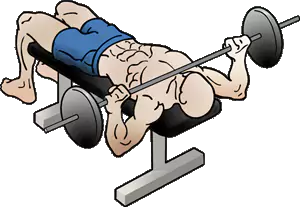



I stood in the aisle as Muscle Man packed heavy plates onto the bench press machine. When he got onto the bench press, his head was just a few feet from me while I was looking down at him studying how he was lifting. After that machine I followed Muscle Man from station to station, learning about each exercise. I was so engrossed in following his work-out that I noticed he never once made eye contact with me, even though I had been standing just a few feet away from him the entire time. His head was always kept down. After this continued for quite a while, I got the feeling that something was wrong. I sensed that Lou, the gym owner, didn't tell Muscle Man that I was instructed to watch him and follow his work-out.
Muscle Man seemed somewhat frustrated. He then put his hands out slightly to the side and shook his head. He proceeded to the locker room. Realizing that I might have ruined his work-out, I decided to go into the locker room also and apologize to him. Muscle Man at the time was in the bathroom section of the locker room when I walked in. So I had waited for him to come out. The locker room was small and dimly lit. When he came out, I must have startled him because he fell back against the wall. His head was tucked downward. I started to apologize to him but he didn't seem interested in what I was saying. He then tried to pass by me so I reached out to touch his arm to get his attention. I was baffled by his sudden reaction to me; he looked very scared. He backed away, never once looking at me. I had never seen this behavior from such a huge guy before, particularly from someone a lot bigger than myself. I'm five foot eight, and at the time, I was one hundred and fifty pounds. He was about six and a half feet tall and about two hundred and seventy pounds.
This was happening all while I was standing in the doorway between Muscle Man and the rest of the gym.
I apologized to him once again, but this time speaking louder while I was bent over at the waist looking up into his eyes. Not realizing this, Muscle Man was hard of hearing. He read mostly lips. I must have gotten through to him when he looked into my eyes while I was speaking because it was then that he smiled. He then seemed relieved.
It seems that because Muscle Man was so big, he never had to learn how to defend himself. He asked Warren to teach him the martial arts. Muscle Man told me that Warren said to him (and without my knowledge) that I would be there that night observing him and assessing whether I would approve of him learning martial arts lessons from Warren or not. Of course, Warren never needed my permission to give anyone martial arts lessons. And that was part of the joke Muscle Man was the butt of.
After Muscle Man told me this, I started laughing and said, "Warren doesn't need my permission" I replied, "he can teach any one he wishes to without my consent."
(An explanation before I continue: I was injured years ago while doing a judo demonstration at a public school on the auditorium stage. I landed on my neck, and ever since then, my head always had a tremor or a shake). Muscle Man told me that Warren said to him "I was quick as lightning, and possibly a very dangerous person. And if I ever felt threatened or if someone was looking at me the wrong way, my head would start shaking (my head tremor) – which was the indication that I might lose control and do something drastic, such as grab someone by the throat and rip their throat out."
No wonder why Muscle Man seemed nervous when he was alone with me in the locker room: my head was shaking uncontrollably and I had been inadvertently cornering him against the wall because I was trying to apologize to him. I explained to Muscle Man the story about why my head had a tremor. That seemed to clear things up between us. It was obvious at this point that we were both in on someone else's joke.
Muscle Man then winked at me and said "Stay here. And watch this!" He went out to the gym area and called out loudly, "Lou! Warren!" And as they both approached, he immediately got them into a head lock and started jumping up and down yelling, "You guys think you're &$%#@ funny, don't you!?" Everyone in the gym busted out laughing and one guy (who may have been in on the joke, though I wasn't sure) was on the floor holding his side laughing in tears.
I found out that Muscle Man had won many body building shows.
Some time later, my wife and I were at a body building competition. Just as we sat down, I heard a voice behind me I recognized. I turned around and lo-and-behold, it was Muscle Man. I introduced him to my wife. Not long after, Muscle Man moved to California and became a famous movie star.
Perhaps you might have guessed who Muscle Man is: the "Incredible Hulk," Lou F.
Remaining in contact with my students in New Jersey
Often, I had traveled back to New Jersey to visit my black-belt students where they lived. It was much easier for me to travel to them rather than having all my students travel to me on Long island. We had association meetings, black belt work-outs, and large testings for students looking to get promoted. I tried to visit my students four to six times a year.
Visiting a black-belt student. Martial arts injury number two.
McGuire Air Force base


McGuire Air Force base


During one of my pre-arranged trips to New Jersey, I had visited one of my black belt students, Forrest B. The following morning, we both decided to work out at McGuire Air Force base on the grass in an area where we wouldn't be disturbed. The grass was still wet from the sprinklers earlier that morning. We placed our belongings on the sidewalk which was only a few feet away from where we would be working out. We started off with some warm-ups and stretching. Then we went into our usual techniques. As we became more involved, we started moving faster. As a result, somehow we interlocked in midair and lost our balance. And Forrest came down on top of me with my shoulder hitting the cement walkway very hard. We continued for a moment or two until I realized I could no longer raise my left arm above my shoulder. I began to feel pain in that area. We both called it quits for the day.>
Clavicle bone injury
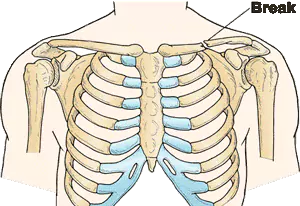
As my body cooled down and the endorphins began to wear off, the pain became more severe, especially during my three-hour drive home. I didn't sleep that night. The next day I went to the hospital and found out that I had fractured my clavicle bone (also called the collar bone). The collar bone is the horizontal bone that's attached between the shoulder and the upper rib cage. The doctors told me that the break was pretty bad and surgery was required. A screw was put into the bone (to keep it in place) in order for it to heal. When I no longer needed a sling, I found it difficult to do any kind of left arm punches, grabs, or movements that required me to apply pressure on my left shoulder.
It took a good six months for my shoulder to heal properly before I could start using it again.
Opening my second martial arts school with another Master.
After leaving my old martial arts school – which was a bad situation – I decided to start fresh and find another place to teach at. However, I didn't have enough investment capital to open a new school due to the overhead and everything else.
Master Chuck M.
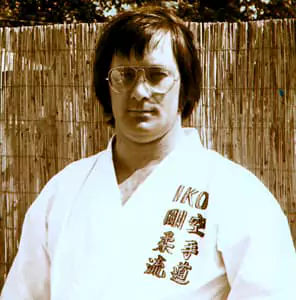

Master Chuck M.


Once in a blue moon, luck would smile upon me. Most of the black belts in the New York tri-state area knew each other. That's how I found out about Master Chuck M. He was already teaching here (on Long Island) and had his own school in Oceanside. It was located about a mile from my first school and on the same road. Soon he was moving to Connecticut. Chuck rented a nice size space from a Judo instructor on the second floor. After meeting with him, my only obligation he said was to take over his rent payments each month which included all the utilities. I partnered with Master Andrew L. (a Japanese Shorinju-Ryu stylist) to take over the school. While Master A.L. taught, I operated the front desk and vice versa.
There had always been a conflict between Japanese and Korean style martial artists, worldwide. But with Master A.L. and myself, we never had a problem. We were both very knowledgeable and excellent martial artists, and we both had respected each other for that. Master A.L. taught his style and I taught in the evenings and on Saturday mornings. Our teaching hours alternated. Our students were allowed to take either of our classes or both if they decided to (which some did). After some time passed, the owner of the building decided that the space we were renting would be more profitable if it were rented as an office space. He gave us sufficient time to close our school. Meanwhile, Master A.L. had the opportunity to move further out on Long Island which he had always wanted to do anyway. I was working full time at a major television company at the time (which was my day job) and was commuting back and forth from Long island to New York City.
Sometimes I wonder if I made the right decision by not renting out another location and keeping the students I currently had.
My third martial arts injury
Third martial arts injury:
pinky frozen into place
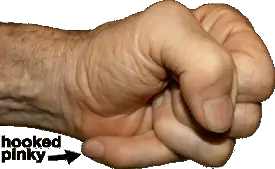

Third martial arts injury:
pinky frozen into place


While teaching at my second school, I always made it a point to fight with every student, even if it was for only several minutes. My classes were an hour and a half long. One day, while fighting one of my adult green belts, Ted F. – suddenly he stopped and started shaking his arms. Ted told me that my blocks were hurting his arms. So I had decided to fight him with open hands so he would no longer be in pain. Sure enough, Ted did a spinning back kick – which I blocked – and it jammed my left pinky finger. I immediately felt the pain. I looked down at my pinky: blood was everywhere. I excused myself from the class, went into the bathroom where I noticed that my left pinky was only an inch long. The pinky bone was shoved up through my left hand and came out through the palm of my hand. I rinsed off the blood, soaked a large wad of toilet paper and wrapped it around my hand, and went back to the floor and finished fighting the rest of my students.
Looking back, I should have went to the hospital immediately after my injury. But for some reason I had waited until the following morning to go to the hospital. The outcome of having waited so long was that I had an infected hand and a bad injury. Today my pinky is regular size, but hooked (bent) at the last joint, and frozen into place at that joint. When I make a tight fist – which is when my injury is most noticeable – my injured pinky remains straight, and at the last joint it remains permanently hooked. I learned a valuable lesson from this experience: always seek medical attention immediately after an injury occurs, and never fight with with an open hand.
While running my second school, I tested my students in a realistic situation
During my earlier years teaching at my second school, before the initial start of class, I had always informed my students that what they were about to learn is the real thing, and that they should never hold back during class – of course, within the guidelines of safety.
During one particular self-defense class, I informed my students that before their last class, they would be tested in a realistic situation to see if they could defend themselves. I told them the test would take place at another location in a run-down part of town almost at dusk and would last into early evening after the sun went down. They were also informed that students from my advanced, adult men's class from another school at another location in town would also be there, and that they would be confronting them (as their attackers). (My adult men's class by the way, never met my self-defense students prior to this event). I gave my self-defense students a choice when they were confronted by my adult men's class: they could either defend themselves, or run. I figured a real-life reenactment would be a great lesson about the importance of not letting one's own fears be one's own worst enemy.
When the day of reenactment arrived, students from my adult men's class came early at the proper location. (After looking at my self-defense students, I noticed they were constantly going to the bathroom). I was amazed at how dirty and grungy looking my adult men's class students made themselves out to be. They looked downright scary. They also seemed eager and excited to role-play the real thing. I had given my adult men's class a choice of weapons to choose from: a realistic pistol, rubber clubs, rubber knives, and other weapons. By them using fake weapons had ensured no one got injured. The fake weapons however looked real, and my self-defense students didn't know they were fake.
Fake weapons
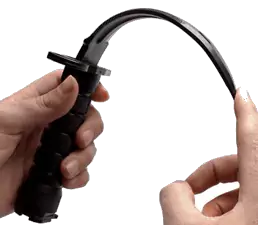
I gave instructions to my adult men's class to be as real as possible, to even use foul language if they wanted to. Before leaving with my self-defense students to the location of reenactment, I explained to them that they were to walk around the block, and as they reached the location, they would be confronted by my adult men's class in a sequence of singular confrontations (a dozen of them) that were set up over the span of one square city block. I also told them that I [personally] would be following short distance behind them, observing. When I got to the proper location with my self-defense students, I placed them at a further distance away but close enough to where they wouldn't see or hear any of the action going on as each student was confronted at the scene of reenactment. (The element of surprise is very important). As the first self-defense student nervously walked into the unknown, my largest and tallest student (from my adult men's class) walked toward him on the sidewalk as if he wasn't involved in the reenactment. At the last second, he grabbed the self-defense student and held a knife out in front of him. The self-defense student didn't hesitate to disarm the [attacker's] knife and take control of the situation. Then afterward, another student (from my adult men's class) snuck up behind him from in-between two parked cars and attacked him from the rear. Another student after him was crouched in the shadows, waiting to attack.
Each student must have been attacked a dozen different ways (as they walked around the square city block).
When reenactment finished, my self-defense students couldn't believe what just happened to them. They were all excited and talking about it as if it was the real thing. It was a proud moment for them and a fun time for everyone. I was proud of all my students. And my self-defense students came through as I had expected them to. I also felt confident that, if any of my students were to find themselves in an actual life-or-death situation, that they would have a better chance of surviving.
It didn't occur to me at the time of reenactment to borrow a video camera and record all the action. However, my student's performances and their creative use of imagination, and how scary they made themselves out to be – and how they reenacted real attackers in such a life-like way – would rival any movie (in my opinion).
My martial arts career almost came to an end
My excavation business:


My excavation business:


I owned an excavation demolition company back in the 1980's called, "I Move the Earth Dirt Cheap Inc." My employees and I operated heavy-duty equipment: large Mack trucks, bull-dozers, front-end-loaders, back-hoes, and much more. While working on tall buildings we usually used skid-steer-loaders (Bob-cats), particularly inside buildings because of their power, small turning radius, and ability to demolition everything. The skid-steer-loaders were lifted by crane and placed inside the buildings into an opening on the outside wall. From there, we usually started working at the top floor and worked our way down to ground level.
The day of February 3rd 1986
We were working on a three-story high building for several days. It was a large building per/square foot that had a steel structured frame with cement block walls. There were several other company contractors there working on different parts of the construction site.
Not the actual building of my accident

The building had been scheduled to be demolished in about one week. My contract was to salvage anything that was reusable and remove all partitions on all the upper floors. What we couldn't save had to be removed. All the remaining debris was taken out or pushed through the opening on the outside wall of the building using a skid-steer-loader, where it fell back down to the black top below. There, the debris was carted away and removed by another contractor.
The building (in the picture) was not the building I was working on, but gives an accurate depiction of the type of construction project I was working on.
Skid steer loader (Bobcat):


When I arrived at work, my crew already had started working on the top level floor, the third floor. I immediately went up to them and started working. Before long, it was lunch time. We usually didn't watch the clock before lunch. Instead, we just went to lunch whenever we felt like it, or we took lunch when we were free (from our duties). It must have been around twelve thirty or twelve forty-five when my six men crew went out to lunch. I remained behind and continued working on the top floor. I remember wanting to get a head-start on a pile of debris that was in the way that needed to be cleared (using the skid-steer-loader) before my crew returned.
The other general contractors there that day – those not part of my crew – knew we were working on the upper floor for the past several days. They were well aware of that fact. They were working down below on the ground floor, pushing the building's block walls away from its steel support structure using a 40,000-pound bull dozer. The bull dozer was a big one, a John Deere 850B LT. The steel building was tack welded (spot welded) in each of its corners.
John Deere 850B LT
(not the actual machine)
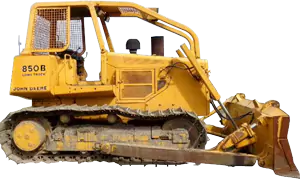

John Deere 850B LT
(not the actual machine)


The upright beams held up the cross beams which supported each floor. If the building had been built correctly – where the upright beams and cross beams came together – the beams would have been fully welded and/or bolted together. When the beams were inspected after my accident, they found them to be only tacked (spot welded) together; a cheap but fast way to build. I have been in the excavation and demolition business for years and I knew my craft well. There are good contractors, and there are bad ones. Bad contractors will find short cuts to save time and money on anything, including material and labor.
At the time, I was working on the top floor. I was about thirty to forty feet away from the building's edge from the opening of the outer steel structure. Other sections were still closed off by the building's original, outer block wall. The second and third floors of the building were cemented blocks. Even though I was on the upper floor, I could still feel and hear the bull dozer working below, pushing away the concrete walls. Occasionally, the bull dozer brushed up against an upright steel support and shook the entire building a little. On the far corner of the building, below me (from where I was working), the bull dozer was pounding against the corner wall, which had a walk-in reinforced, steel safe, similar to a bank safe.
As the bull dozer operator continued working below, tragedy struck. I was on the upper floor when the bull dozer operator lifted and pushed the upright corner beam – which was attached to the safe – out past the buildings edge, leaving no support for that corner of the building. As a result, the building started collapsing in that corner, starting a chain reaction that caused the other steel upright beams holding up the upper floors to collapse as well. I noticed the floor I was standing on (the third floor) started dropping in the far corner from where the bull dozer hit the beam and was heading towards me.
At that point, my life flashed before my eyes. This happened twice before in my life. The experience is like none other. You don't have time to think. Everything is a mere reflex, fight or flight. Thoughts are processed in less than a second. As many others have described in near-death experiences, everything slows down as if you could see events unfolding before your eyes, your entire life, starting from childhood all the way up to present time, as if it happened in a mere second. That is when you realize how wonderfully magnificent and powerful the brain is.
When the floor started dropping, I ran fast, so fast that I probably could have ran on water. I ran all the way to the edge of the building to where the opening in the wall was. Luckily I made it to the building's edge before the floor completely collapsed from underneath me. I then grabbed onto the outer I-beam of the building with my right hand and swung all the way around to the outside of the building using my left hand and foot firmly placed on the same beam. I was left standing on the outside of the building with my foot and arm supporting me. I figured that the floor would stop collapsing when it reached the edge of the building. But no! instead, the cross-beam that supported the roof above me let loose and started dropping down towards my hands and feet. I had no choice but to jump backwards away from the building, avoiding both my hands and feet from being trapped against the steel cross-beam I was standing on.
At this point, I was in midair falling away from the building, falling from the third floor. Not knowing whether I had acted on impulse, I twisted my body before hitting the ground so I wouldn't have landed on my back or head onto the frozen, hard black-top below. Luckily I had landed on my feet. I fell about twenty five feet or so. When I landed, I rolled under my Mac truck which was about fifteen feet away. I didn't want any of the steel or cement blocks coming down on top of me. Luckily I made that decision because parts of the building came crashing down afterwards onto where I had originally landed.
The next thing I remember is hearing my crew workers yelling "Where is Gene!? Has anybody seen him!?" When my crew found me, they pulled me out from underneath my truck. I had severe pain in both my ankles. I remember asking them to help me stand up but I couldn't, so they laid me back down on the black top. The pain kept increasing. Instead of calling an ambulance, two of my crew men lifted me up and placed me into my foreman's car. They laid me on my back in the front passenger seat with my head towards the glove compartment and both my legs resting over the top of the front headrest. This helped decrease the pain because both my feet remained above my heart. My foreman then rushed me to the hospital (which was about ten minutes away). On the way there, the pain continued to increase rapidly to the point where it was nearly unbearable. I felt like I was ready to pass out.
South Nassau Hospital,
Oceanside, NY
(emergency entrance)

Once we reached the hospital, my foreman grabbed a wheel chair from the emergency entrance and brought it for me to sit in. Once in the chair, I held both my legs up in the air using both my arms to help alleviate the pain while he brought me inside the hospital. A nurse then immediately brought me to the emergency room and placed me on a gurney. They removed my sneakers and socks.
Soon after, an orthopedic surgeon came over and gave me an injection to relieve the pain (which I believe was morphine). X-rays were taken,and the orthopedic surgeon informed me that both of my heels and ankles had multiple fractures. He said that if I had weighed any more, my spine would have never have been able to support my body weight from the fall, and I would have been a paraplegic the rest of my life. They put both my legs into casts and I was bed-ridden at home for several months. During that time, I did a lot of meditating, and in particular, writing in the martial arts.
During the time of my recovery, I went to physical therapy several times a week. Unfortunately, the range of motion in my ankles never improved. Both my ankles froze into place. I only have about twenty percent range of motion in my left foot – from forward to backward – and about thirty percent movement in my right foot. To this day, I still have no lateral movement whatsoever in both my ankles. I also suffer from chronic discomfort, to debilitating pain daily, depending on the weather conditions.
Because of my accident, my martial arts improved dramatically.
Whenever I have a strong desire to achieve a goal, I always remain determined to succeed no matter the obstacles and always manage to overcome them. The positives in my life supersede everything else, and the negatives take a back seat. In my situation, with my physical disability from my accident, it was a mental challenge to not have pain affect me in a negative way.
Because of my injury, I now have limited mobility from my ankles down. I had to relearn what my legs and body were capable of doing after my injury. I also had to readjust to a whole new lifestyle. At first, I focused on only one simple task. After that, I focused on other simple tasks and repeated them. Having achieving those goals, I then joined my simple tasks together to complete a series of movements.
Grand Master
Gene Perceval
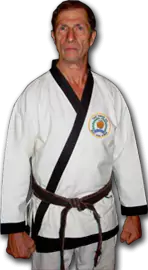

Over a period of years, I learned how to function in a way which my body would allow me to, and to the best of its ability. As a result, I understand now how energy travels through the body.
I then used that knowledge and experience to improve my martial arts skills in a new kind of way. My punches, kicks and movements became much more powerful and required a lot less effort even though I had lost most of my range of motion and flexibility. I used to believe that it would take ten lifetimes to completely understand the martial arts.
Now I know that that's not true – there is a formula: a way of thinking and understanding that I unfortunately had to learn the hard way that every martial artist should and can follow, regardless of their style. The formula is the way of the mind, body, and spirit, in the martial arts, all working together in harmony.
To me, the martial arts is really simple, it's just that martial artists make it very complicated.
I have been constantly developing Mind-Body-Spirit Martial Arts to present day. (Back to top)
Mind-Body-Spirit Martial Arts
